Visit Manheim and the energy is palpable! Creativity – with a nod to history – is helping to take the borough in a new direction. There’s also another precedent at work – many of the business enterprises are owned and operated by husband-and-wife teams.

The steel sans serif numbers are from Timber Made Design Co., a husband-and-wife duo (Derek and Chelsea) whose work can be seen at Prussian Street Arcade.
I dragged photographer Jordan Bush all over Manheim during a two-day period in May. The New Holland native admitted he had never really ventured to this area of the county. “I never had a reason to come to Manheim – not even for a football game,” he shared. After leaving SUPPLY, he made a telling observation. “I feel like I’m in another state,” he said. On day two, he requested that we revisit Mill 72 Bake Shop & Café. After visiting with Willie Wrede at ARTifice Ales & Mead, he announced, “I’m definitely coming back here.”
Celebrate Manheim
1st Thursdays
 Municipalities across Lancaster County have been enticing people to visit their downtown areas by hosting monthly “First” events, so why not Manheim? That’s exactly what members of the Manheim Area Chamber of Commerce were asking, so a group was put together to explore the options, which led to the development of 1st Thursdays. “We thought we’d stay away from Fridays,” says Jason Horst of Horst Arts, who is involved in the event. “We’re excited!” So, it seems was everyone we talked to in Manheim.
Municipalities across Lancaster County have been enticing people to visit their downtown areas by hosting monthly “First” events, so why not Manheim? That’s exactly what members of the Manheim Area Chamber of Commerce were asking, so a group was put together to explore the options, which led to the development of 1st Thursdays. “We thought we’d stay away from Fridays,” says Jason Horst of Horst Arts, who is involved in the event. “We’re excited!” So, it seems was everyone we talked to in Manheim.
The monthly event kicked off June 3, with nearly 30 participants, including downtown (and outlying) restaurants and businesses. Going forward, plans call for the event to feature food trucks, live music, activities for the kids, a walking tour and special events in Market Square. The next First Thursday is July 1.
Chipping in to Develop a Creative Environment
REO Manheim Marketplace
Barney and Suzanne Reiley could have called it a career after selling the three environmental related businesses they owned. Instead, the couple decided to pursue a business venture that would help to get Manheim moving in a new direction. They formed a development company – Staudt McGovern Holdings, LLC – and began attending workshops and seminars that focus on turning small-town downtowns around. Then, they began to actively look for an underutilized property and give it a new purpose in life.
They found exactly what they were looking for along Main Street in Manheim – a 1.4-acre property that had once been home to an auto dealership, garage and a snack food company. The venture, which they named REO Manheim Marketplace, would tap into their previous business experience, as it would create a new “environment” for a complex of buildings that was languishing. The project, which benefited from the talents of Steven Funk of LeFever Funk Architects, entailed razing two (of six) buildings and updating the factory spaces to create an industrial-chic look for what is now the Prussian Street Arcade. The former dealership and garage is now home to Mill 72 Bake Shop & Café and two short-term rental apartments, while another building hosts ARTifice Ales & Mead. The last space has attracted the attention of other potential tenants and the Reileys hope to have it filled and operating by year’s end. “Just this complex alone has created more than 60 jobs in Manheim,” Barney notes.
According to the Reileys, the premise of REO Manheim Marketplace is rather simple: A rising tide lifts all ships. That theory is apropos to the experience that awaits: You could spend an entire day here, beginning with breakfast/lunch at Mill 72 Bake Shop & Café, shopping at Prussian Street Arcade and ending it with dinner (and some relaxing axe-throwing) at ARTifice Ales & Mead. And, that doesn’t even take into account all the other attractions that Manheim now has to offer.
Even the Reileys are a little taken aback by the instantaneous success of REO Manheim Marketplace and its ability to weather the Covid storm. “Last fall, we had a doctor from New York reserve one of the REO Suites,” Barney explains. “She had worked non-stop from March to September and just wanted to get her kids out of New York. We told her Lancaster was still kind of shut down, but she didn’t care. She just wanted to get out of New York. They had a great time and the next thing we know, we’re getting reservations from other front-line workers and first responders. We stay booked.”
The Reileys view their enterprise as a way to give back to their adopted hometown and credit their neighbors, Michele and J.P. Perron, the owners of The Booking House, for encouraging their creative energy and channeling it in a direction that would benefit Manheim. The Reileys, in turn, hope their venture will inspire others to invest in Manheim. “You know, Manheim has always been a crossroads of sorts. People would come through Manheim on their way to other places,” Barney says of Lititz, Lancaster, the PA Renaissance Faire and Mt. Gretna. “There was no reason for them to stop here. We want to change that. We want Manheim to be the best Manheim it can be. We’re not Lititz, we’re not Columbia and we’re not Lancaster. We’re Manheim, and we’re proud of that.”
It seems that the success of REO Manheim Marketplace has rallied the troops and caused others to take notice. “Change builds change and fortunately Manheim has some really good things going for it,” Barney says. “We have a great local government,” he says of Mayor Scot Funk’s leadership. “We have new blood in town,” he says of the investors who recognize Manheim’s potential and are buying and repurposing properties. In turn, new investors and business owners are helping to grow the Manheim Area Chamber of Commerce. “Its membership has grown from 135 to more than 200 businesses,” Barney reports. “And, those businesses are community-minded – they are the businesses that support local events and your kids’ sports teams.” Finally, like other small business owners, Barney and Suzanne are indebted to residents of the Manheim area for the support they have provided to make REO and other new businesses thrive in daunting times. “They really come out and support small business,” he says.
Suzanne also has kudos for people like Holly DeKarske of Venture Lititz and Kelly Withum of Mainspring of Ephrata who have been very supportive of Manheim’s efforts. “Lancaster County is such a supportive place,” she says. “You can call anyone with questions and they are there to answer them and provide you with their support.”
51 N. Main Street
reomanheimmarketplace.com
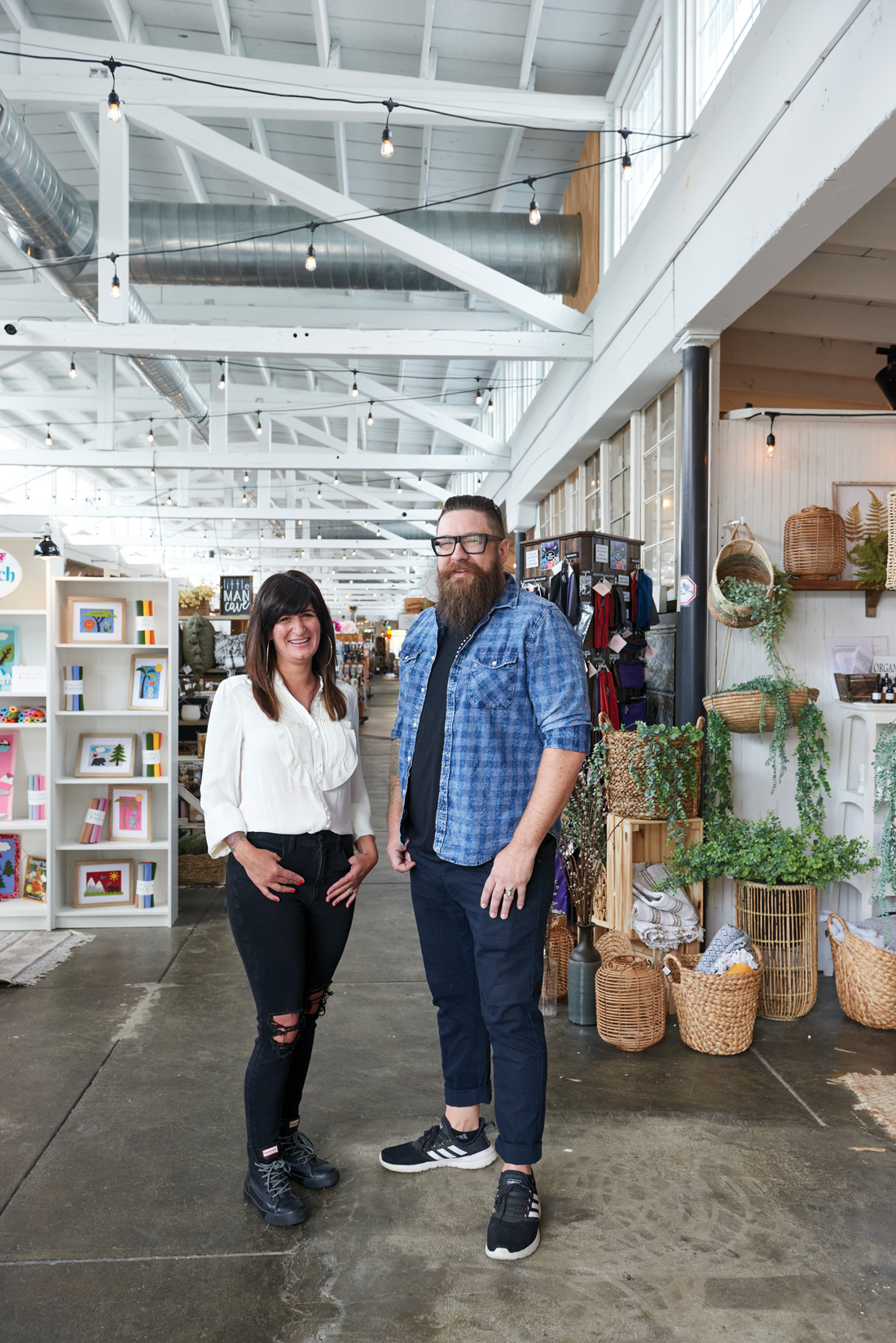
Susan and Michael Ferrari, the owners of Prussian Street Arcade, love being partners in life and business. “We’re so happy to be here,” says Susan. “It still feels very new to us.”
Making It
Prussian Street Arcade
When the redevelopment of the Bickel’s Snack Foods property got underway, Susan and Michael Ferrari, who live nearby, couldn’t help but to notice … and dream. The entrepreneurs, who have stepped back from their other businesses in order to oversee Prussian Street Arcade on a full-time basis, envisioned the former factory as the perfect place to launch a marketplace where makers, collectors, artists, designers, traders and curators could display and sell their items without having the overhead of a stand-alone shop or gallery. “There are no stipulations about [vendors] having to be here a set number of hours or days,” Susan explains. “We’re here to help makers and others grow. The plan allows them to do what they do best – make things – and for us to take care of selling them.” Essentially, Prussian Street Arcade operates according to the old adage of finding strength in numbers.
Suzanne and Barney Reiley liked the concept – in fact, it mirrored exactly what they were looking for – and the Ferraris were in business. Prussian Street Arcade opened in November 2019 with more than 100 makers, artists and other micro-businesses filling spaces of various sizes. From the outset, Prussian Street was a hit. Business during the 2019 holiday season was beyond the Ferraris’ expectations.
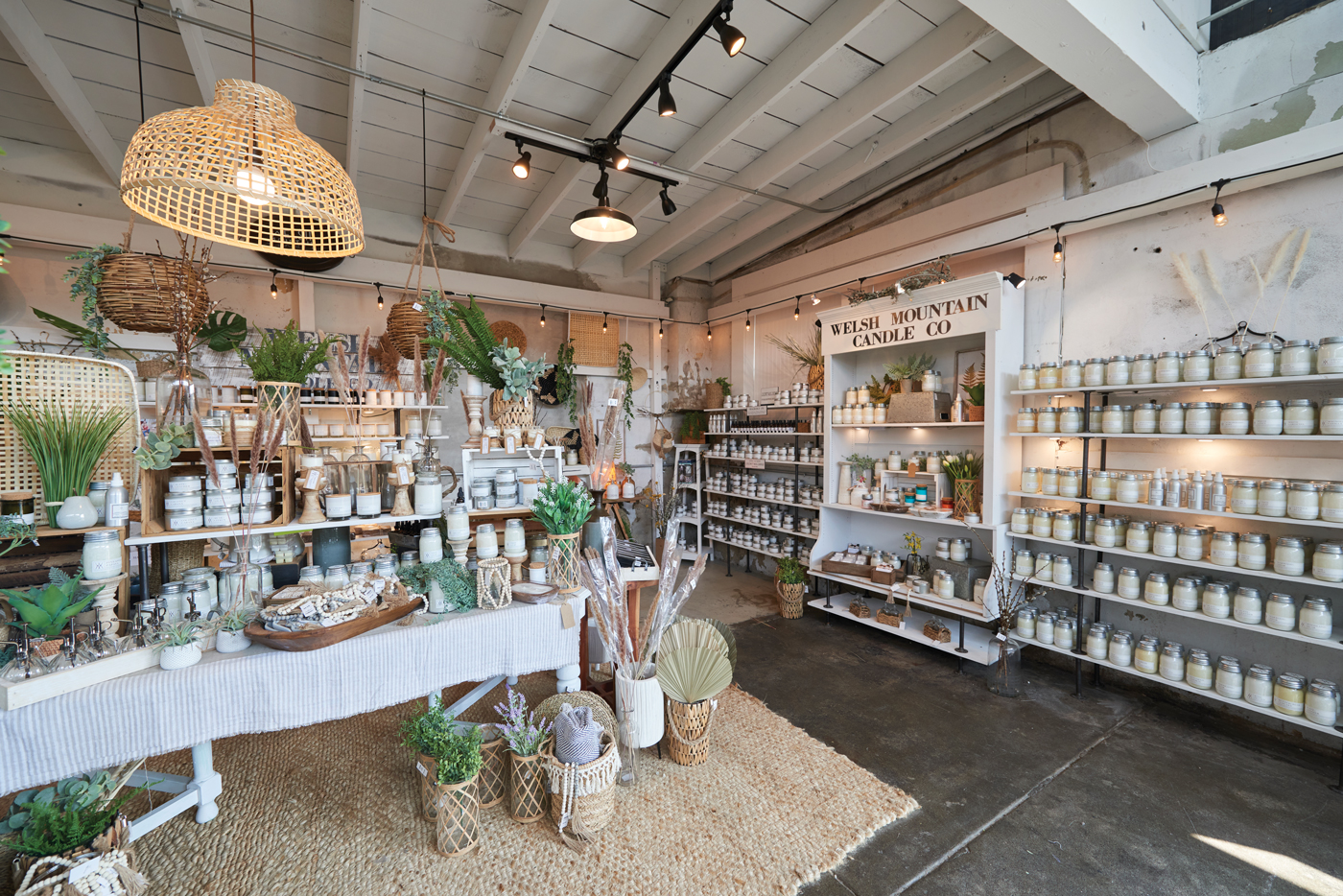
Welsh Mountain Candle Co.’s display area has grown three times since becoming a vendor at Prussian Street Arcade.
Now, almost two years later, Prussian Street Arcade continues to thrive and grow. “Lots of stars aligned,” says Susan of launching the ambitious venture. “You know, I think we approached this with the right combination of ignorance and arrogance to make it fly,” says Michael.
How did their dream become a reality? Susan, who has been a maker for years, says the idea for Prussian Street was inspired by the maker community she discovered online. “A real kinship exists there,” she adds. That online community sparked a movement that has given way to the introduction of large and small pop-up events as well as venues such as Prussian Street Arcade, all of which provide shopping experiences that emphasize handmade, vintage, curated and collected items. “I always enjoyed visiting Building Character in Lancaster,” Susan says. “Plus, we’ve been shopping at vintage markets for what seems like forever.”
Still, Susan’s vision deviated from what she was seeing take place across the country. “My vision was boutique-like spaces that would really showcase a vendor’s artistry or creativity,” she explains. The airiness of the space would only lend itself to the atmosphere they hoped to create. Indeed, the whole industrial-chic vibe – a white backdrop, eye-catching displays, the right soundtrack, high ceilings and lots of windows – prompts you to slow to a stroll and take in the countless items you never knew you needed or wanted but now must have. With bag in hand, you’ll find yourself hurrying to get home and find places for your new-found treasures.
Of course, Covid presented its challenges. “Four months in and we had to close. We were terrified,” Susan recalls. “Especially when it became obvious that Covid would be more than just a three-week thing,” Michael adds. “There was no handbook to guide you through something like a pandemic.”
So, they got “creative” and began emphasizing online sales. They introduced shopping by appointment in May (2020). Susan began to fill baskets with vendor items and sell them through social media sites. They created theme displays in the vestibule of the building to bring cheer to visitors. “Revamping the vestibule every month made us feel better, too,” Susan notes. With fall’s arrival, traffic returned and the holiday season was better than they expected. Now, it’s back to full steam ahead.
The creative energy that pulses through the building is invigorating and inspiring. “I didn’t know what to expect when we announced we were looking for makers to fill the space,” says Susan. As it turned out, she had no reason to worry. The space filled in no time and now accounts for nearly 120 vendors. “The vendors sold it for us – word of what we were doing spread quickly,” Michael recalls. “We now have a waiting list,” Susan reports.
Need any more encouragement to schedule a visit? Photographer Jordan Bush says he now “gets” why his fiancée, Jessica, loves to shop at Prussian Street. “This isn’t at all what I was expecting,” he says. “I could see myself coming along with her on occasion.”
49 N. Main Street
prussianstreetarcade.com
A “Slice” of Manheim History
Mill 72 Bake Shop & Café
Open since February 2019, Mill 72 is owned and operated by Melanie and Brian Miller and their daughters McKayla, Taylor, Morgan and Payton. “The neat thing about doing this as a family is that each member has something to contribute,” Melanie shared in an earlier issue of LCM.
Located in a “slice” of Manheim history – the REO Manheim Marketplace – Mill 72 took over the space that once served as a showroom for an Oldsmobile dealership and a garage. Now, it’s a light-filled café that, according to Melanie, invites guests to “connect, unwind and enjoy delicious food.” By connecting, she means face-to-face or virtually. The dining area that mimics a living room – fireplace and comfy furniture – is always filled with guests.
The delicious food comes courtesy of Morgan, who loved to help her mother in the kitchen as a child – “We baked lots of cupcakes,” she recalls – and took advantage of the food program offered by Lancaster County Career & Technology Center as a high school student. Breakfast (baked oatmeal, breakfast sandwiches, quiche, bagels and parfaits) and lunch (soups, salads and sandwiches) items are available all day.
The beverage list is extensive – we visited two days in a row to order Frozen Chai. Jordan said it might even surpass his favorite beverage at the legendary Café du Monde in New Orleans.
When you visit, be sure to save room for dessert – the cupcakes, pies, cookies, brownies, macarons and other sweet treats are delectable!
45 N. Main Street
mill72.com
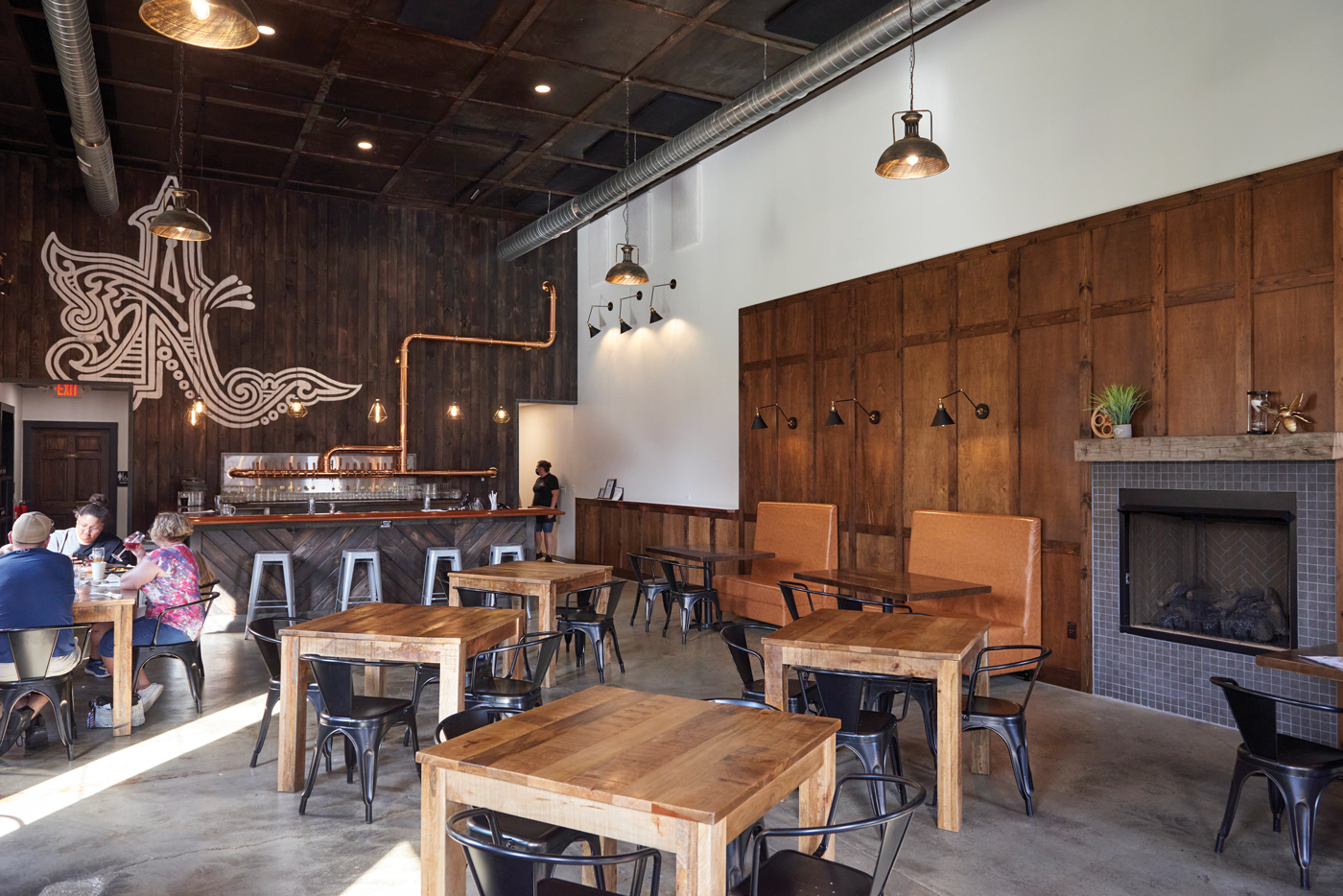
ARTifice Ales & Mead makes its home in a building that once served as Bickel’s packaging/shipping department.
A “Honey” of a Business
ARTifice Ales & Mead
Willie Wrede warned us when he greeted me and Jordan at the front door of ARTifice Ales & Mead that he can wax poetic about mead all day long. Then, he offered us samples of his honey mead. Jordan was leery, explaining the only mead he had ever tasted was so sweet it made his teeth hurt. “That’s the thing about mead,” Willie explains. “Everyone makes it differently. You have to keep tasting it until you find what you like.” With that in mind, we sampled Willie’s mead. Jordan’s eyes lit up. “Now, this is good,” he marveled. Walking back to the car, we tried to come up with an apt description of what we had tasted. It was crisp but not cloying. It almost had the consistency of lemonade. “A shandy,” Jordan offered. No matter what, we declared it to be refreshing and very tasty – the perfect summer drink.
Ah, but according to Willie, mead is much more than a summer thirst quencher. “Mead is for all seasons,” he points out, noting that you can drink it cold, at room temperature or hot (it’s perfect for making holiday glogg). And, like wine, there is a mead to pair with whatever cuisine – “Pizza to 5-star,” he says – you may desire. Willie also advises that if you are a fan of craft seltzer, give mead a go. Mead also makes for a good mixer in cocktails. “A Mead Mule is gluten-free,” he points out.
How did Willie become a fan of mead? Always a devotee of fantasy fiction, Willie immediately became aware that a libation called mead or “honey wine” often plays a role in the stories. He notes that mead was prominent in ancient mythology. He also relates that mead just might be the oldest alcoholic drink in the world. “Every culture had a brewing tradition,” he explains, noting that in the beginning, brewing was women’s work. He tells of the Romans, who upon invading the British Isles, made copious records that told of all the honey that existed. They also studied the lifestyle and diets of the people and noted their longevity. “The only thing they could attribute it to was the availability of honey and with it, mead,” Willie elaborates, adding that with the passage of time, honey became a trade commodity. “It was widely used for medicinal purposes,” he adds.
Willie, who had experimented with crafting his own beer in the early 2000s, was curious. Fortunately for him, a craze for mead was developing. “I kept hearing and reading that mead was going to be the ‘next big thing’ in the craft brewing world,” he says. He tasted his first brew at the PA Renaissance Faire, but found the drink to be too sweet for his palate. The bar wench solved the problem by mixing what was left of the mead with a stout beer to create braggot. Willie liked what he sampled and began crafting his own small-batch concoctions and entering them in competitions.
Then, the former Marine, Army reservist, helicopter mechanic and independent government contractor, took the next step – a huge one – and became part of a niche market by opening Meduseld Meadery in Lancaster in 2017. “The writing was on the wall that I was going to be losing my job and I started looking for a new venture that would allow me to stay home and support my family,” he says of launching Meduseld, which is named after a mead hall in Olde England.
When a neighboring business vacated the building, Willie was offered the space. Not knowing what to do with an extra 3,500 square feet of space, he took notice that axe-throwing was becoming a thing. He and some friends checked out a venue in Philadelphia and came away convinced that axe-throwing would be the perfect complement to mead. “We had a blast,” he recalls. While patrons in Lancaster were developing a taste for Willie’s mead, the buzz about axe-throwing really helped to put Meduseld on the map.
Willie, who is a resident of Manheim, took notice of what the Reileys were doing and initially approached them about leasing production space. However, they were looking to bring in a restaurant or brewpub and passed on his idea. Willie began to mull his options and realizing that a void for breweries existed in Manheim, went back to the drawing board and presented a new concept to the Reileys that would incorporate brewing and food. “Through the Army reserves and as an independent contractor, I traveled the world,” he explains. “I really got into the street food I discovered in Korea, Europe and Central America. I wanted to bring that concept to Manheim.”
He also envisioned what his mead hall would look like and worked with Duane and Michelle Gingrich of DMG Building Solutions in Manheim to redesign the exterior and interior spaces of what had been the packaging/shipping department of Bickel’s Snack Foods to achieve an old world-modern look for ARTifice.
Willie, his wife Julie, his sister Jeanette Soler and her husband, Alfonso, and friend Duro Rajkovic – “He’s been my brewing buddy from the beginning; in fact, we experimented in his kitchen,” says Willie – have created a gastropub where pairing the international-inspired menu items with the selection of mead, ales and craft beer is the new game in town. Speaking of games, fans of Meduseld will be happy to know that axe-throwing has made the move to Manheim.
55 N. Main Street
artifice.beer
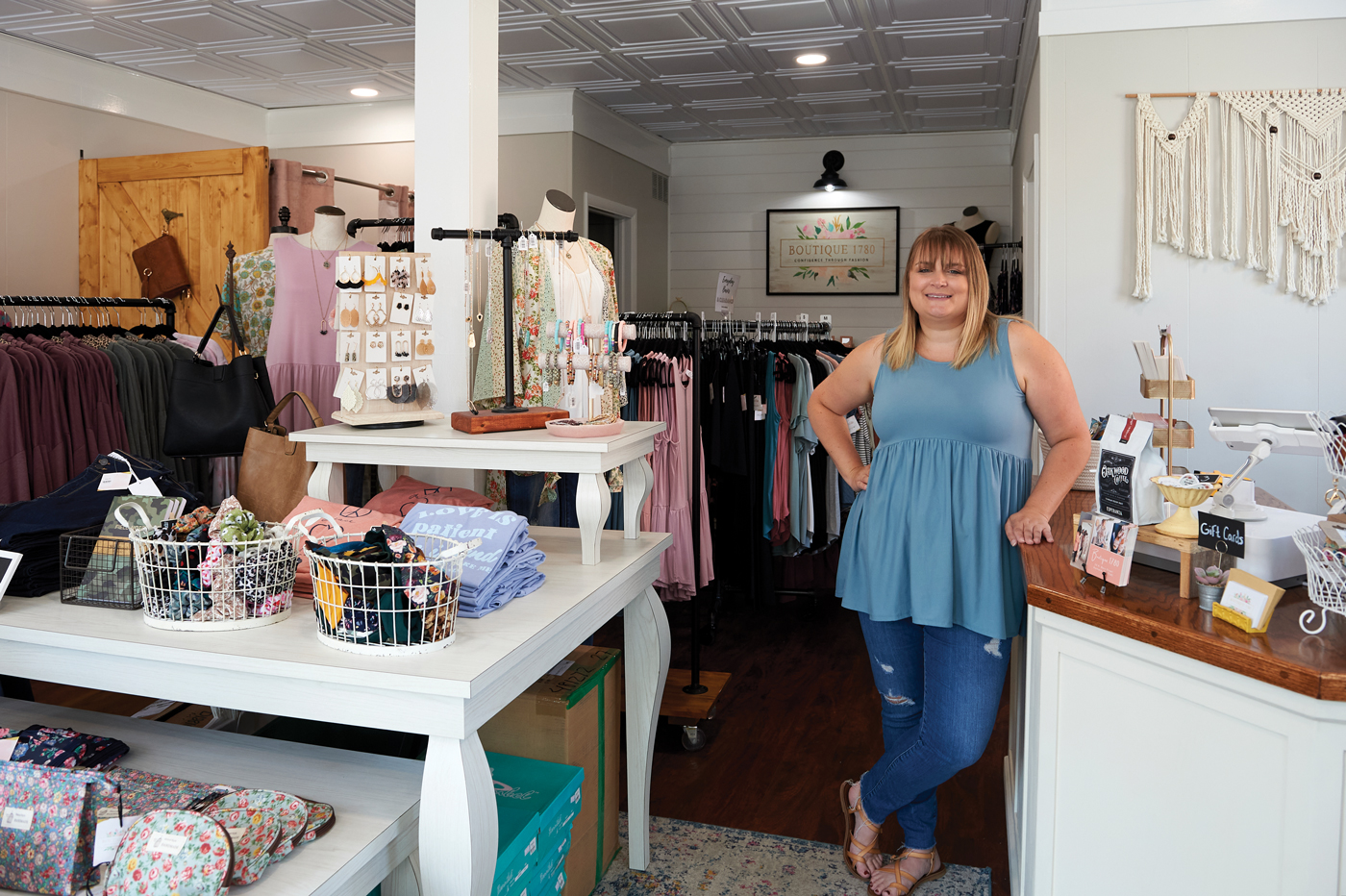
Ashley Martin, owner of Boutique 1780, is a Prussian Street Arcade alumni who opened her own Manheim storefront in April.
Welcome to the Neighborhood
Boutique 1780 and Horst Arts
It seems the Reileys’ wishes are coming true – one of Prussian Street’s tenants, Ashley Martin, moved across Main Street and opened her first Boutique 1780 storefront in April. It was Suzanne Reiley who alerted her to the fact that a salon would be vacating the building in order to move to a larger space. Ashley toured the space and deemed it a perfect fit.
It was only a few years ago that Ashley launched her fashion enterprise – clothing, accessories and gift items – in her garage and then took it mobile via a Winnebago (for pop-up events) before moving to Prussian Street Arcade (she continues to maintain space at Artisan Mill Co. in Lititz).
While the selection covers the size spectrum – small to 3X – Ashley’s buying strategy is motivated by a particular customer – moms. “I still remember that feeling of nothing fitting right after I had my second daughter,” she says of moms being the catalyst for stocking the shop with clothing that is both “comfortable and fashionable.” Her social media sites also reflect her mission to be inclusive, as models represent all body types. “Some of them are customers,” she notes. On the drawing board is a coffee bar whose proceeds will benefit Hope Inspire Love, which addresses sex trafficking and sexual exploitation.
Another REO neighbor is Horst Arts, which is owned and operated by Jason and Katherine Horst, who have called Manheim home since 2010. Katherine is from the Pottstown area, while Jason hails from Robesonia. The two met through attending the same church in Lancaster. Initially they shared space in another building along Main Street. When it was sold, they began searching for a space that would allow their talents – and visions for the future – to collaborate and expand.
Friends connected them with a building near REO Manheim Marketplace that dates to 1910. Jason spearheads the graphic design and web development aspect of the business, while Katherine, who is a graduate of Pennsylvania College of Art & Design, has her fine arts studio in the front room, where she creates mixed-media collages using everything from paper to greeting cards, newspaper print, sheet music and magazines in her designs. “Paper is my thing!” she says.
Together, the Horsts host maker’s events that are typically held on weekends. “I have so many ideas on what we can do with our space that sometimes I get ahead of myself,” Katherine admits. “That’s the beauty of working with your spouse – he or she can encourage your ideas or make you slow down and think about them. This isn’t a 9-5 kind of business – we’re constantly thinking of ideas and bouncing them off each other. We support each other in this crazy idea of ours!”
The maker’s events are held in the space that separates Katherine’s domain from Jason’s. It’s furnished with a unique handcrafted round table that is perfect for both collaborating and social distancing. “We’ve been hosting lots of private events, as well as events that are open to the public,” Katherine explains. In addition to the maker’s space, the Horsts offer those hosting private events the use of a kitchen and a patio.
Boutique 1780: 24 N. Main Street, boutique1780.com
Horst Arts: 17 N. Main Street, horstarts.com
The Hot Spot in Town
Stiegel Glassworks 1976
Two blocks from where Henry William Stiegel’s glassworks once stood, you’ll find a small building in the vicinity of the train station – now the home and museum of the Manheim Historical Society – in which glass objects are once again being made. Launched in the 1960s by a group of Manheim-area businessmen as a way to carry on the tradition started by Stiegel prior to the American Revolution, this modern version of glassblowing took center stage during the Bicentennial celebrations that were held in Manheim in 1976.
Forty-five years later, Stiegel Glassworks 1976 represents more than an art form, as it is an organization whose survival depends on the support of local businesses, the Manheim Historical Society, the borough, volunteers and the art-loving public. For example, the glassworks’ latest acquisition, an electric furnace, was purchased with the help of the borough. On the day we visited, Jeremy Friedly and Hallie Krebs were hard at work creating glass rosette paperweights for the upcoming Festival of the Red Rose at Zion Evangelical Lutheran Church.
Jeremy, a local artist whose passion for creating glass objects began at HACC’s Harrisburg campus more than 15 years ago, manages the operation. Jeremy found the medium to be so interesting that at the age of 17, he began working at Ryan Blythe’s glassmaking studio in Lancaster. He went on to become a fixture at such studios as Through the Fire in Columbia, GoggleWorks in Reading, and Jewell Gardens in Skagway, Alaska. Art is in his genes – his father, Milton Friedly, has been an art professor at Elizabethtown College since 1987 and is an award-winning fine artist, potter and sculptor, as well as a curator and a sought-after judge for art shows.
As for Hallie, the New Hampshire native has been involved in flameworking for nine years, first in Philadelphia and now in Manheim. “Glassblowing is what took me to Philadelphia,” she explains. “Covid is what brought me to Manheim,” she says of choosing to quarantine here in order to be close to her sister. “It’s so great to have this here,” she says of Stiegel Glassworks 1976. “I never went back to Philadelphia.”
Jeremy says he loves the art form for several reasons. First, he appreciates the discipline that is needed to create glass. “Glass demands discipline – something I lacked as a kid – and determination. It’s both a technical and physical craft. It makes me focus.” He also appreciates that the process involves heat that burns so intensely (2,400 degrees) that the glass initially takes on a water-like appearance. “It’s going to do what it’s going to do,” he explains. “It’s the human element that creates art.” He also marvels at the fact that glass is both fragile and enduring. After all, shards of glass dating to ancient times can still be found.
As the president of the organization, Jeremy is also charged with marketing the glass objects that are created on the premises. In addition to Stiegel Glassworks 1976’s studio, glass art is available at the Prussian Street Arcade and at Longenecker’s True Value Hardware Store in Manheim. He also has been taking Stiegel Glassworks on the road to area arts and craft shows. Tours of the studio and “Create Your Own” sessions are also available.
When I remarked that his stemless wine goblets would be perfect for gift giving – notably weddings and house warmings – Jeremy smiles and says he has regular customers who think along those lines. Once he accomplishes the Festival of the Red Rose assignment, he says he will turn his attention to fall. “Glass pumpkins are a big seller for us,” he says.
210 S. Charlotte Street
stiegelglassworks.org
History Lives!
Manheim Historical Society
Several years ago, I attended Christmas events in Manheim, one of which was an open house at the Manheim Historical Society. I never forgot seeing the Society’s collection of Stiegel glass. Unfortunately, Covid caused the Society’s museum to temporarily close its doors. I really wanted to include photographs of Stiegel glass in this issue, so I went online, completed the contact form and crossed my fingers someone would respond.
The next day, Wes Geib Sr. came to our rescue.
“I have exciting news,” Wes shared as he unlocked the door to the museum. “We are going to be adding to the collection.” The new acquisition, which is being purchased from a collector, is due to arrive at the museum this summer and includes Stiegel glassware, stove fronts and paper artifacts. “The thing about Stiegel glass is that he didn’t sign any of the work,” Wes explains. “We have to rely on the experts to identify Stiegel glass.”
Founded in 1964, the Society’s mission is to “collect, examine, interpret and catalog the documents and artifacts” that relate to Manheim, as well as Penn and Rapho townships. It’s also the Society’s goal to “engage and educate the public on the people, places and events” that helped to shape and create that area of Lancaster County.
The centerpiece of the Society’s holdings is the former train station, the interior of which appears to be frozen in time. Built in 1881, it is believed that Frank Furness, who did work for the Reading Railroad, designed the building. It became a thriving place from both a shipping and social standpoint. When rail traffic began to wane in the 1950s, the station began to show signs of neglect. In 1976, it was closed. Vandals caused more disrepair.
Fortunately, the building had good bones and at the behest of a young girl named Melissa Boyer to save the building, the Historical Society and other interested parties went to work. The $40,000 that was needed to buy it was raised, while grants were secured for the restoration work. Today, it’s filled with furnishings, equipment and other items that convey the heyday of the station. History lives here!
The Manheim Historical Society also oversees the Heritage Center (research center), the Fasig House (a restored log house that dates to the 1700s) and the Keath House (another restored log house). It is integral to the operation of Stiegel Glassworks 1976. It played a major role in the restoration of the Birney Trolley Car #236 that once traveled between Manheim and Lancaster. It also played a role in acquiring the Town Clock and moving it to the park on Market Square in 1994 and restoring it in 2009.
Despite being closed for the past year, its members – 600 strong – have been busy behind the scenes. A new website will soon be making its debut. Plans are underway to reopen the museum this summer and resume activities such as the popular Folk Art Show that is held in early December. And, a walking tour is being designed as part of First Thursdays activities. “You have to remember, this is an all-volunteer organization,” says Wes, who serves as vice president.
88 S. Grant Street
manheimhistoricalsociety.org
“Bridging” Fun and Agriculture
Manheim Community Farm Show
Peruse the farm show’s Facebook page and it’s immediately obvious that Manheim is raring to go. Fundraisers driven by barbecued chicken, pulled-pork sandwiches and a golf tournament are being held to raise “seed” money for Lancaster County’s final fair of the season, which is scheduled to take place October 4-8.
Manheim’s farm show has faced its “fair” share of challenges over the last decade, including torrential rains, flooding and of course, a pandemic. Last year, organizers held out hope that the show would go on but in the end, Manheim’s annual event followed the fate of countless others and had to be cancelled.
This year’s show promises to include all the pageantry, animals, crafts, competitions, fair food, creative talents and blue ribbons that make it one of Manheim’s most anticipated events. Yes, the show is fun and educational and celebrates agriculture, but Manheim likes to think that “community” is the secret ingredient that makes it special.
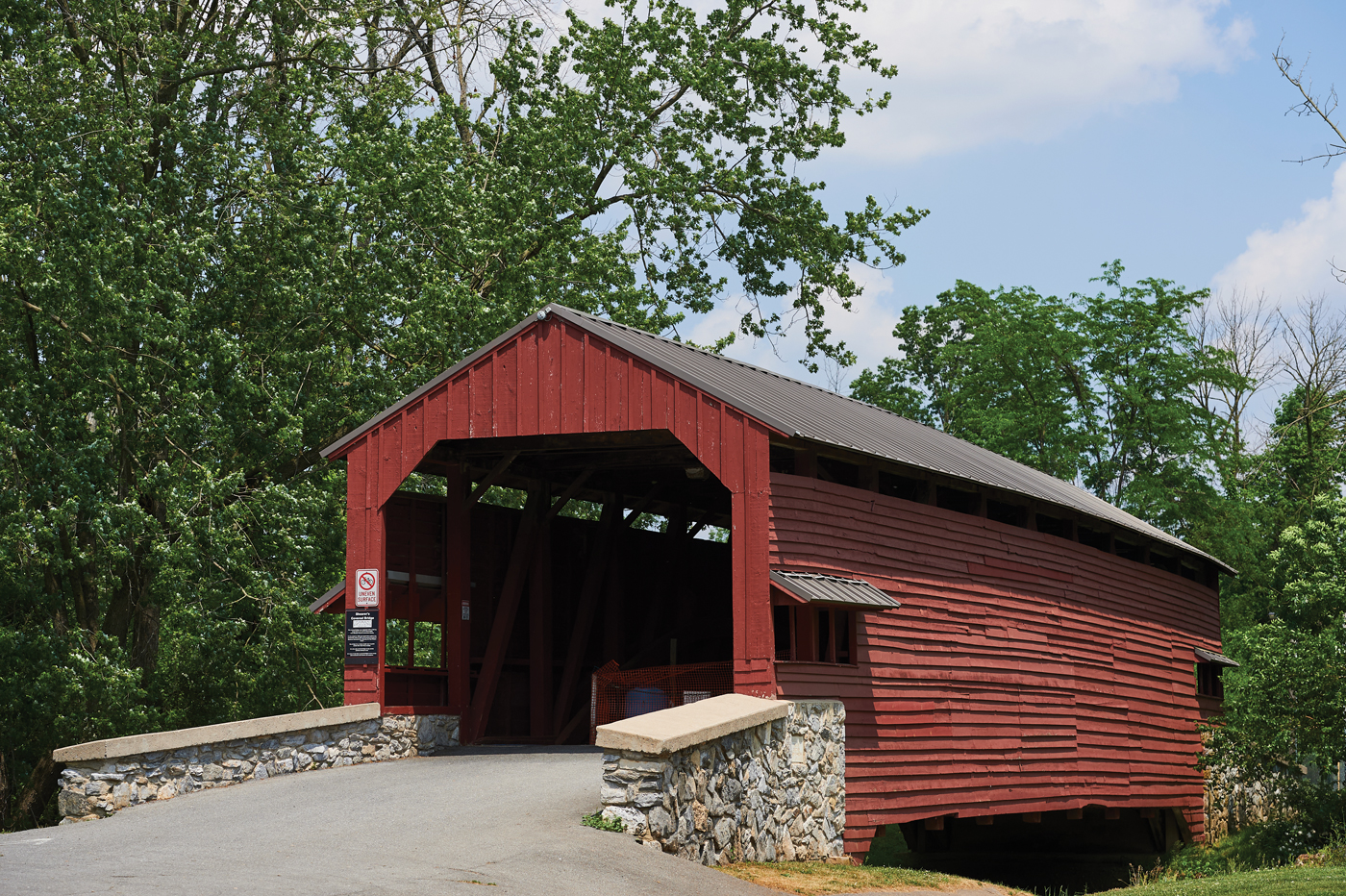
Shearer’s Covered Bridge, which was originally built in 1847, now serves as a foot bridge and is the symbol of the Manheim Community Farm Show.
In Manheim, “community” is a multifaceted word as far as the farm show goes. The mission of the show – to promote agriculture, crafts and competition in a friendly environment – embodies the town’s community spirit. Volunteers donate approximately 5,000 hours of their time during Farm Show Week. Visitors donate to a food drive that is conducted for the benefit of the Manheim Food Bank, while livestock exhibitors support the Central PA and Manheim food banks with donations of protein. All food stands are operated by area nonprofits, hence proceeds are inevitably earmarked for community projects.
Community pride is also evident in the farm show’s symbol – Shearer’s Covered Bridge, which was built in 1847 by Jacob Clare and rebuilt in 1855. It was moved to its present-day location – Manheim Veterans Memorial Park – in 1971. It’s remarkable in that it is the only covered bridge in Lancaster County to be painted entirely red (inside and out). It is one of three in the county to have horizontal side boards. While vehicles no longer cross over it, the bridge sees plenty of foot traffic, as it is used by students on their way to and from school and farm show visitors who utilize satellite parking lots on the other side of Chiques Creek. Tourists love its picturesque accessibility.
Eight years ago, the bridge was in need of a new roof and the Farm Show Committee, along with the school district, the borough and members of Manheim FFA and Manheim Young Farmers, came together to pay for and install one.
502 Adele Avenue
manheimfarmshow.org

Kim and Jan Waltz walk through the vineyards of their farm. Waltz Vineyards began in the Waltzes’ garage in 2000 and today includes a state-of-the-art winery, three tasting rooms/shops and 35 acres of grapevines.
A Farm of a Different Varietal
Waltz Vineyards
Jan Waltz is a sixth-generation Lancaster County farmer. The view from high atop a hill on the farm takes in acres upon acres of grapevines and is so intoxicating that you can almost imagine yourself being in Northern Italy or Central France. Actually, Manheim does have something in common with those two regions – a continental climate that provides optimal growing conditions for grapes. On top of that, Manheim’s micro-climate is complemented by well-drained soil and good air flow.
Convinced he was on to something, Jan and his wife and business partner, Kimberly (both are graduates of Penn State, as well as wine aficionados), began handcrafting wine in their garage in 2000. With each passing year, the couple perfected their fermenting and blending techniques and began devoting more acreage to growing grapes. Seven varieties of grapes – three reds and four whites – are now grown on 35 acres. A buzz about what was transpiring in Manheim began to swirl.
The garage has grown into a state-of-the-art winery that employs the latest wine-making technology from Italy, a French oak aging system and the expertise of Italian enologist Goffredo Agostini. Waltz wines have won awards on state, regional, national and international levels. Its European-inspired tasting room begs you to relax and savor the wide variety of wine (be sure to order the cheese, cracker and chocolate accompaniments, all of which are locally produced).
Two of the wines are named for Henry William Stiegel, including Baron Red, a dry, red blend and, from its Estate collection, Stiegel Rosé, which is created via the French method, siagnée, and is a blend of Cabernet Sauvignon, Merlot and Cabernet Franc grapes. It’s simply delicious!
Ah, but the story doesn’t end there. Waltz wine-tasting dinners have become a staple at several area restaurants. Waltz’s first satellite shop in Lititz relocated from Main Street to The Market at Wilbur two years ago and is now known as Waltz Wine Room. Six years ago, a tasting room and wine shop debuted at Kitchen Kettle Village in Intercourse.
Covid, of course, presented challenges unlike any they have experienced. From March to June (2020), the Waltz tasting rooms were closed. The company pivoted and began offering curbside pickup to customers, as well as shipping and delivery options. “We shipped three times our usual amount in 2020,” says Jan. Kim says it was all-hands-on-deck in the shipping department during 2020. When the Manheim tasting room was able to resume its hours, a reservation system was developed in order to meet state guidelines for occupancy. Fortunately, the Manheim location boasts an expansive outdoor area. “That proved to be a bonus last summer,” Kim notes. “We learned a lot from doing business during a pandemic,” says Jan. “Some practices we’ll retain, others we’ll do away with.”
Jan and Kim are excited by what the future holds. The newest enterprise is growing grapes at Kissel Hill Farm on East Oregon Road, near Lititz. Work began in spring 2015, when an acre was devoted to growing Chardonnay grapes. The inaugural harvest (fall 2017) was used in the production of a Waltz fan favorite, Fusion. In 2018, another acre was cultivated and dedicated to growing Cab Franc grapes. Two months ago, the Waltzes released Kissel Hill Farm’s first small-batch Chardonnay to its wine club members. “It’s been a learning experience,” Jan says of the differences in weather and soil composition between Manheim and Lititz.
The Waltzes are supportive of the new direction Manheim is taking. “So often, visitors to the tasting room will ask for suggestions on what else is available to do in this area,” says Kim. “Now, we can send them into town. We are promoting each other – we send visitors to Manheim and they send people here.”
The Waltzes are thrilled that a new generation – their son, Zach – has joined the family business as director of operations in viticulture and enology. “Zach is bringing education and experience to the business,” Jan says of his son’s degree (Bachelor of Science: Viticulture and Enology) from Cornell University and his work experiences at Gallo in California, and Ste. Michelle Wine Estates in Washington State.
1599 Old Line Road
waltzvineyards.com
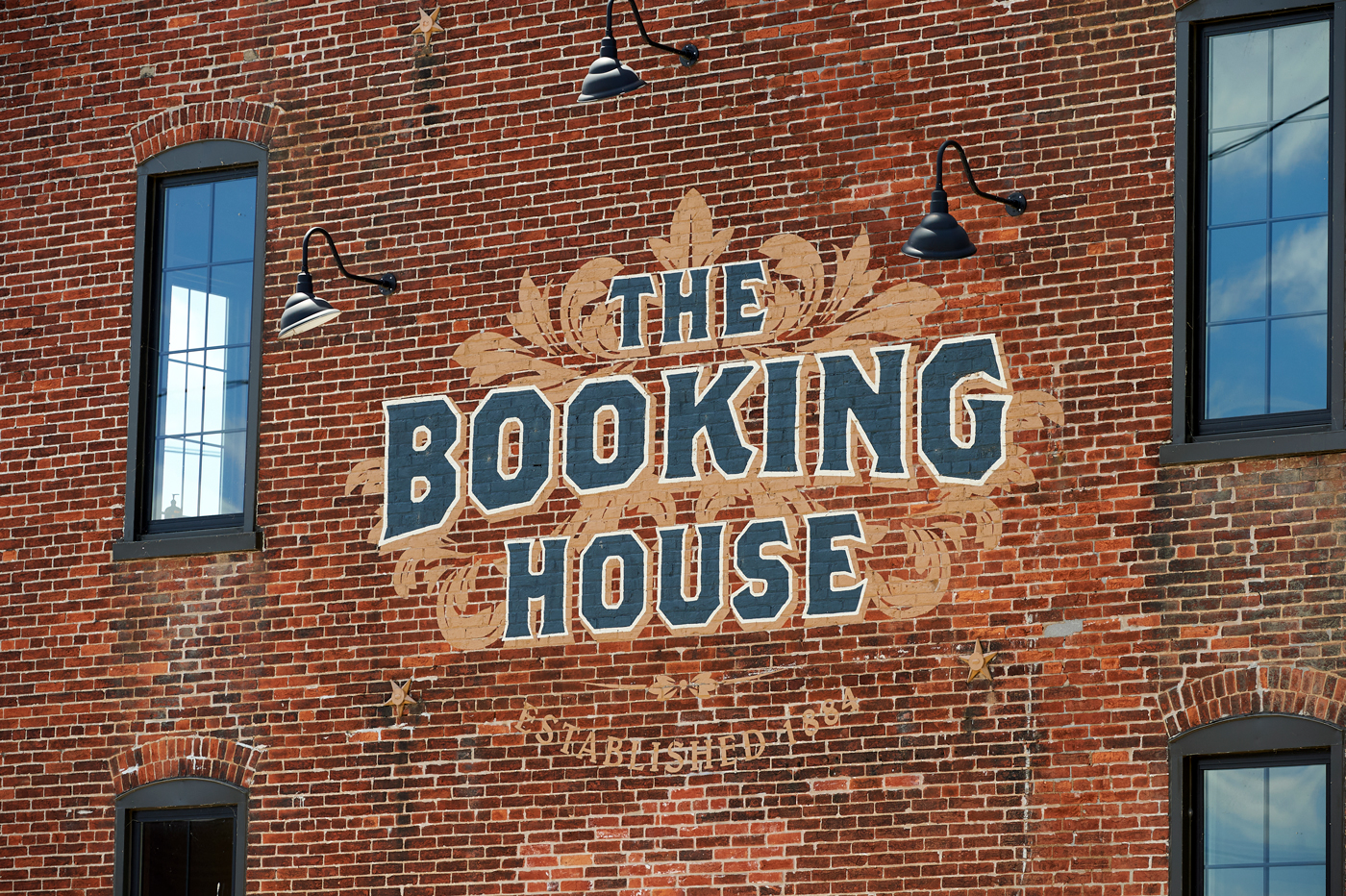
J.P. and Michele Perron transformed a warehouse into a special events venue and won a C. Emlen Urban Award for adaptive reuse.
A “Marriage” of Old and New
The Booking House
About 10 years ago, J.P. Perron was looking for storage space to accommodate his growing construction company. A friend suggested he check out a warehouse on S. Penn Street in Manheim. Built in 1884, the imposing brick building was used to produce cigars for 50-plus years. After that, it was used by a succession of companies for storage purposes. The building would suit Perron’s needs and he and his wife, Michele, purchased it in 2012. When they showed it to friends and associates, they all made the same observation: it would be a perfect venue for special events such as weddings. The Perrons had to agree with that assessment and by the following year, plans were being developed to give the building a new lease on life.
The Perrons viewed the adaptive reuse project as their opportunity to give back to the community and add another unique venue to Lancaster’s fast-growing reputation as a premier destination-wedding locale.
The goal was to retain the charm and patina of the original construction (exposed brick, massive chestnut beams, wood floors, etc.) and add modern-day amenities (new restrooms, an elevator, a new heating/cooling system, handicap accessibility, etc.) to the building. A fireplace, crystal chandeliers, a bridal suite and The Crow’s Nest (cigar lounge/man cave) were added, as well.
Work began in January 2014 and was completed that summer. Later that year, The Booking House was honored with the Historic Preservation Trust’s C. Emlen Urban Award for adaptive reuse.
How did The Booking House get its name? In cigar lingo, it’s a cigar-making technique whereby the roller layers the filler leaves on top of one another (like the pages in a book) and then rolls them up in a scroll. Booking is quicker than other rolling methods but it can create issues with a cigar’s draw if not done properly.
210 S. Penn Street
thebookinghousemanheim.com
A Flowering Career
Cool Spring Garden
Mindi Bruckhart was in search of a new career that would enable her to be a stay-at-home mom to her five children. Fortunately, that dilemma was solved when Mindi and her husband, Jared, moved their family to Cool Spring Farm near Manheim. Jared grew up on the 200-year-old farm that was now the home to new generations of Bruckharts.
Living on a farm got Mindi’s creative juices flowing and it occurred to her that she could parlay her love of the outdoors, nature and tending to plants into a career. The latter was a genetic gift – her mother, Jean Horst, maintained a large cutting garden at the family home in Ephrata. As a child, Mindi was permitted to cut flowers and create her own floral arrangements. No doubt, readers are assuming Mindi became a floral designer. You would be wrong. Mindi became a physical therapist.
Mindi began tending to strawberries, gourds and pumpkins and launched her business venture in 2014 with a table she placed along the roadside. Encouraged by the positive reception it received, Mindi added peonies to the mix the following year. Customers went gaga over the selection of blooms.
Confident in her career pivot, Mindi began growing her own flowers – sunflowers, zinnias, garden roses, dahlias – as well as specialty blooms such as ranunculus, anemones, poppies, lupine, etc. Essentially, you name it and Mindi grows it. The roadside table grew into a country-chic self-serve stand (complete with convenient off-road parking).
Mindi’s new career path veered in a number of directions. She returned to design and now creates arrangements and bouquets for weddings and other occasions in her barn studio. She offers flower lovers a floral version of a CSA. Other floral designers and event planners have become customers. She also offers workshops (both private and open to the public) throughout the year. (The next one is July 21.)
The farm stand, which is open April through December continues to flourish. In fact, it was a career-saver during Covid. While her wedding work nearly vanished, Mindi was kept busy creating arrangements that customers ordered for themselves, as well as for friends and family. “Flowers just make people happy,” she says. “I think last year’s gardening craze points to that. Flowers provided a way for people to stay connected,” she theorizes.
489 Doe Run Road
coolspringgarden.com
18,000 Square Feet of Zen
SUPPLY
Launched in 2016 by a “couple” of friends – Bryan and Heather Zeamer and T.J. and Brooke Mousetis – the SUPPLY building was an industrial warehouse in need of some serious love. Built in 1952 – in a part of Manheim I never knew existed – it was home to a succession of owners and satisfied a number of industrial uses, the last being a recon center.
Today, you would never guess what its past once entailed. Now, it’s an 18,000-square-foot study of total Zen, thanks to soaring ceilings, pristine white backdrops and expansive windows –
all courtesy of the Scenic Ridge Construction Company and Plant + Fig Design. Vinnie DePaul, SUPPLY’s building manager, describes Plant + Fig’s Lori Oberholtzer as the “brains behind all the design and décor work” you see throughout the building.
The premise of SUPPLY is rather simple and straight forward: to offer individuals and teams a place to do business and share spaces such as meeting and conference rooms, an outdoor seating area, a kitchen, etc. According to Vinnie, photographers from all over the region utilize the photo studios that are available for short-term use.
SUPPLY has also been the scene of many micro-weddings – even before they were cool or became a Covid necessity. The minimalistic backdrops and outdoor patio/balcony are perfect for micro-weddings.
280 S. Oak Street
supplymanheim.com
A Drink for the Ages
Mount Hope Estate & Winery
Several years ago, I attended Gourmet Gala, a long-held benefit for the Historic Preservation Trust of Lancaster County. I sampled some cider from Lancaster County Cider, which I learned was part of the Mount Hope Estate & Winery umbrella. Oh, my gosh, was that cider tasty! I bet I visited the stand a half-dozen times that afternoon.
Fast forward to May 2021. Jordan and I were doing photography for the July cover. He looked at the cans of Lancaster County Cider I had brought along and said he wasn’t crazy about cider but admitted he based his opinion on the products of an industry giant whose products are frequently advertised on television. I took a sip of the Sweet Cider and nirvana set in. Jordan sampled it … and sampled it again. He changed his tune. “This is good from start to finish,” he proclaimed.
Lancaster County Cider is one of nearly 60 cideries in the state (pre-Covid). Washington State, which ranks as the top producer of apples in the United States, is home to nearly 80 cideries. Lancaster County Cider was launched in 2016. Its hand-crafted products are made from locally sourced apples and other natural ingredients. In addition to its signature dry and sweet ciders, the company makes special/seasonal ciders that are tinged with fruit such as blueberries, pineapples, cranberries and blood oranges. Pumpkin cider is a fall sensation, as is salted caramel. In addition to shops affiliated with Mount Hope, it is distributed by Kirchner Beverage.
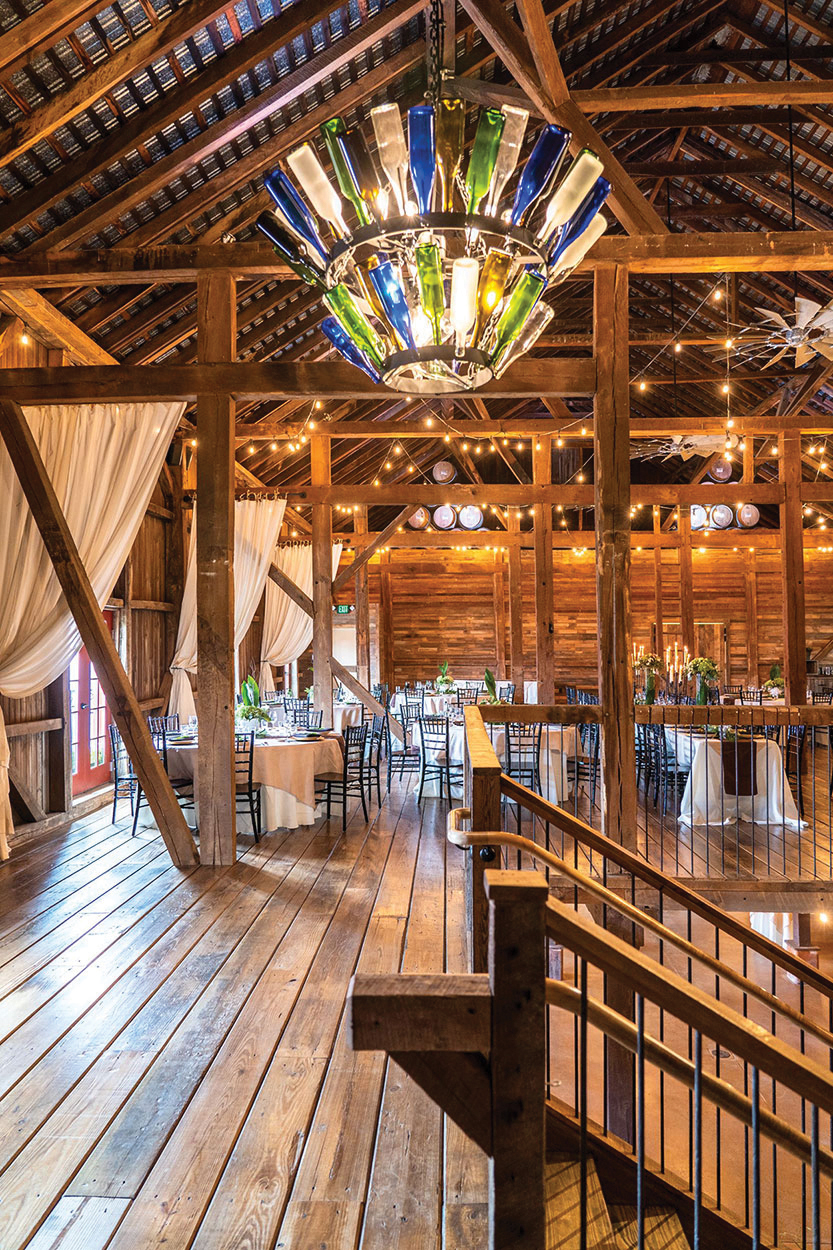
A restored barn at Mount Hope Winery that is used for special events features a creative chandelier made from wine bottles. Nick Gould Photography.
You might say that cider – the fermented variety – is as old as the hills. Throughout the 13 original colonies, hard cider was the beverage of choice. According to National Geographic, cider made sense – it was simple to make, was cost-effective and the ingredients were plentiful.
As you might guess, cider also became a “wonder drug” as it was said to aid digestion and prevent rheumatism, gout, bladder stones, colic and the list goes on. It was also believed that cider aided longevity. Legend has it that John Adams always started his day by drinking a tankard of cider and he lived to be 91.
It was also said that cider fueled the American Revolution. Ethan Allen preferred a concoction of cider and rum that gained the name, Stonewall. Legend has it that the Green Mountain Boys’ bravado came courtesy of the drink in the hours leading up to the capture of Fort Ticonderoga.
Prohibition spelled disaster for cider. Like other alcoholic beverages, cider was banned. Temperance advocates went so far as to burn and destroy apple orchards in order to ensure cider couldn’t be made. Unfortunately, in their zeal, an untold number of heritage varieties of apples were forever lost. When Prohibition was repealed, cider failed to stage a comeback – beer became the preferred beverage. Most people came to know apple cider as the brown-colored beverage that has become the buzz-free mainstay of fall festivals and harvest celebrations.
The craft-brewing movement that got underway in the early 2000s began with beer and grew to include seltzer, mead and cider. Penn State even has a cider authority on staff in Carla Snyder. The craft movement also helped to foster small distilling companies and boutique wineries.
Interest in cider steadily climbed through the last decade in the United States. According to a study by Penn State (conducted before Covid), hand-crafted cider enjoys a solid following, which has prompted the growth of cideries and tasting rooms, food pairing events, cider-based cocktails and research by fans into apple varieties. Interest in cider is also being driven in part by demand for gluten-free and low-alcohol beverages. With Asian markets embracing cider, sales and market share are expected to increase internationally.
You say you’ve driven by Mount Hope a gazillion times but unlike the 200,000 visitors to another business under its umbrella – ever hear of the PA Renaissance Faire? – you’ve never stopped? Believe me, there’s a lot to discover. First, though, a little history is in order.
The property was purchased in 1779 by Peter Grubb, who built an iron furnace there in 1784. His son, Henry, built the estate’s Federal-style mansion over a five-year period beginning in 1800. Formal gardens also took root. Succeeding generations of Grubbs used the estate as a summer home.
It wasn’t until Daisy Grubb (1850-1936) moved to Mount Hope that it had a permanent resident. She enlarged the house in 1895, bringing it to 32 rooms and adding Victorian elements to its design. Following her death, the estate was subdivided and sold. After a succession of owners, Chuck Romito purchased the property in 1979, with plans to transform it into a vineyard and winery. A year later, he welcomed guests to Mount Hope Estate & Winery.
In order to attract visitors, Romito held special events, including a jousting tournament staged by members of a club in Maryland. The success of the jousting event prompted Romito to hold a one-day Renaissance Faire in a parking lot on the property. The rest is history. The PA Renaissance Faire has grown into a 13-week extravaganza that is held weekends, August through October. You might describe it as the area’s largest dinner theatre, as it entails food, drink and entertainment spread over 35 acres.
The Ren Faire has been owned by Scott and Heather Bowser since 2005. Prior to that, the couple owned a restaurant in Manheim (Summy House), where Scott established a small brewery – Swashbuckler Brewing Co. At Romito’s invitation, Scott established a small brewery at the Ren Faire in 2000. He also became the president and CEO of the Ren Faire’s food and beverage division.
Mount Hope has grown exponentially over the last 15 years. In addition to its wine, beer and cider operations, a distilling company joined the lineup. A restored barn now hosts weddings and other special events. The mansion is the scene of theatrical, musical and comedy productions. Theme festivals dot the calendar. Satellite shops can be found throughout the county, as well as in Gettysburg and Shrewsbury. And, a drive-in movie theatre will be in operation once again this summer.
2775 Lebanon Road (Route 72)
mounthope.estate





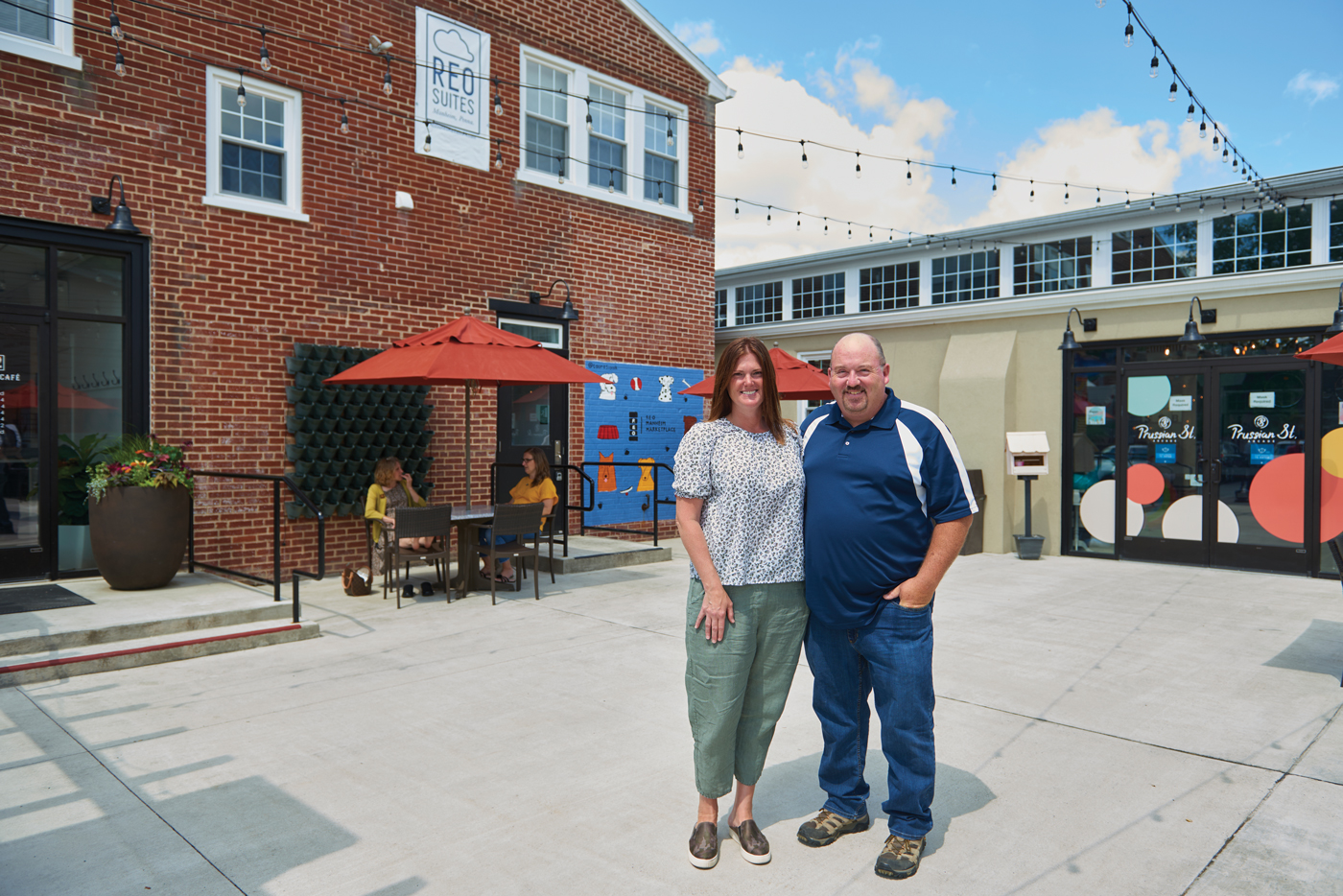
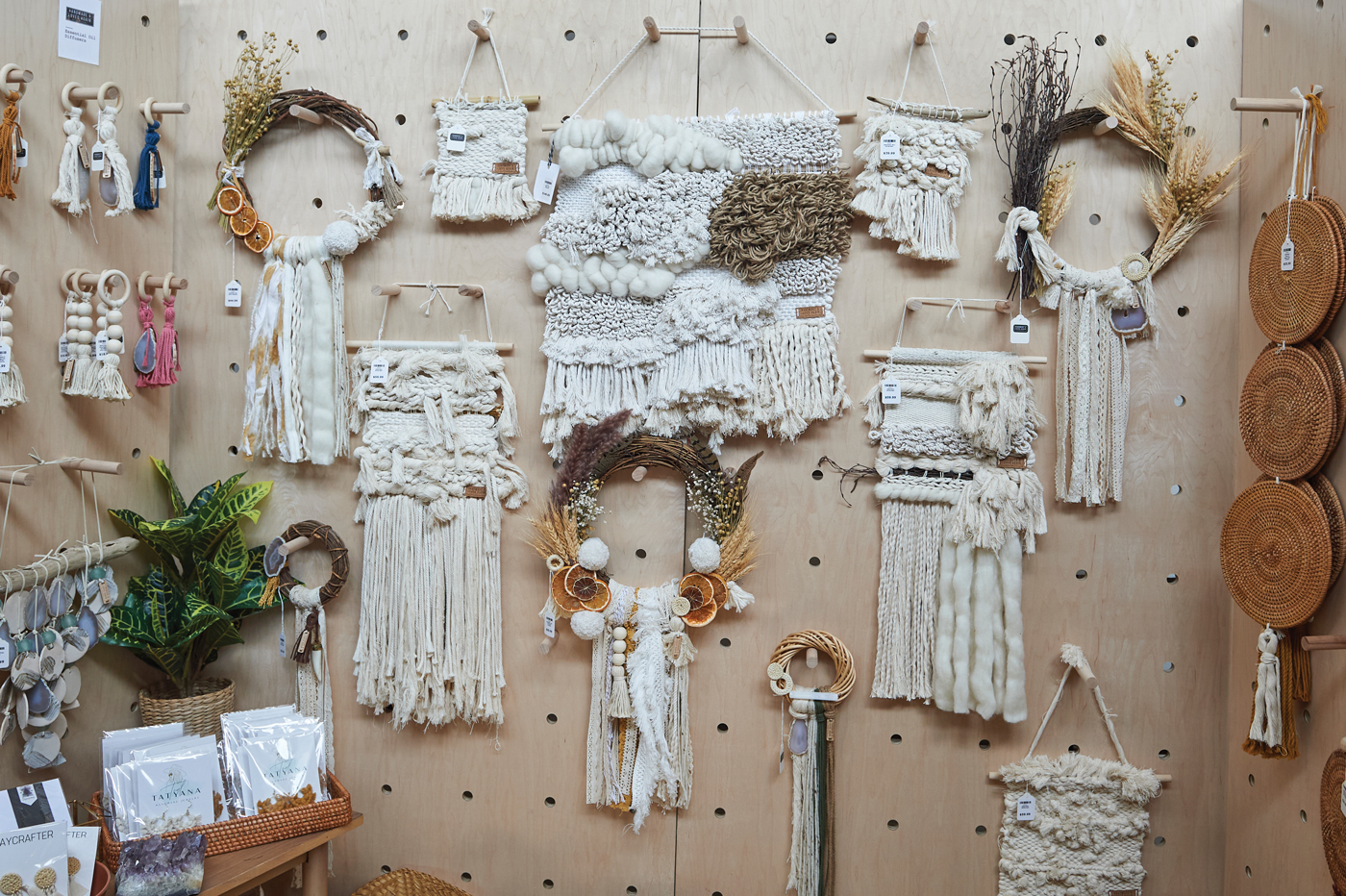
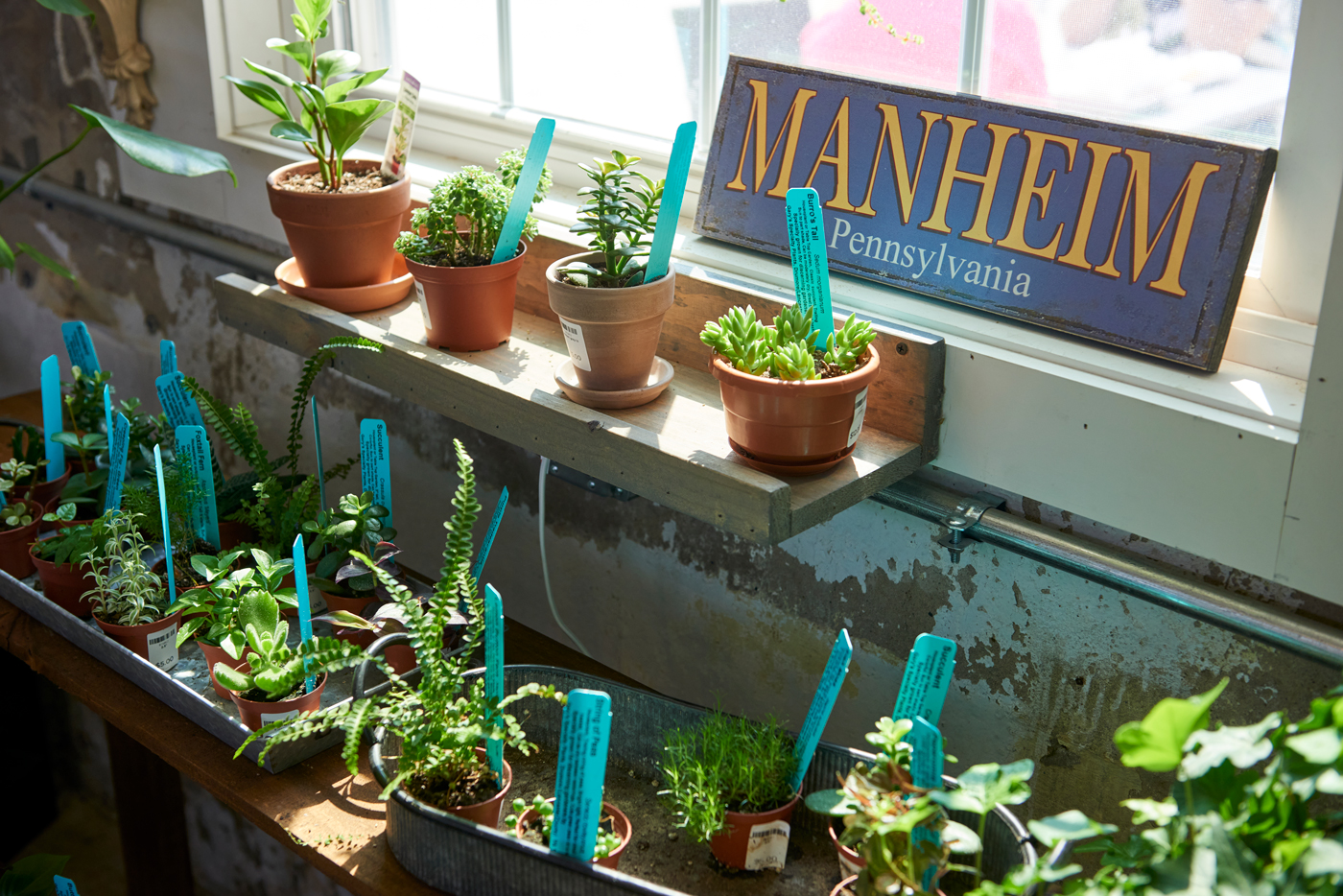
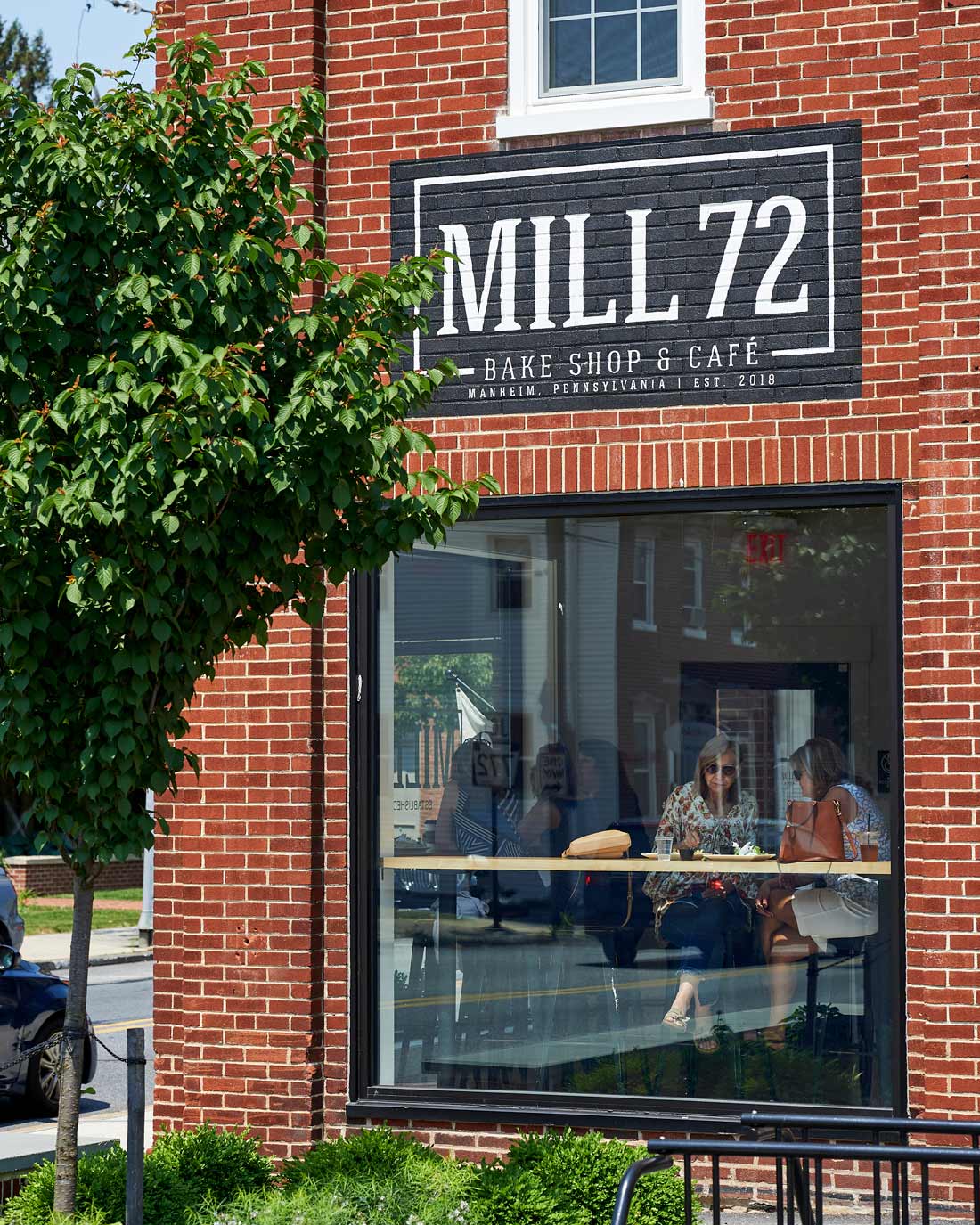
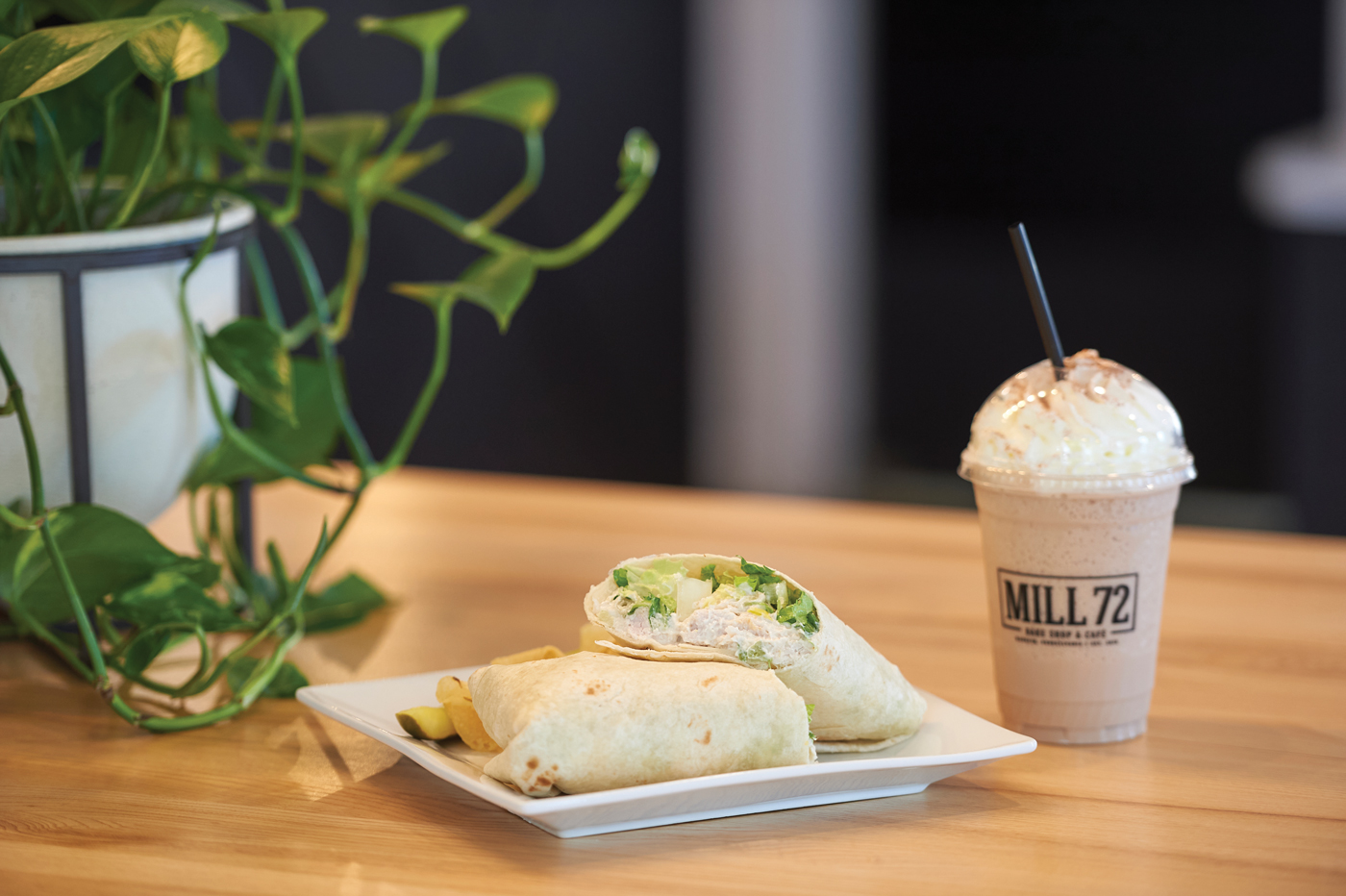
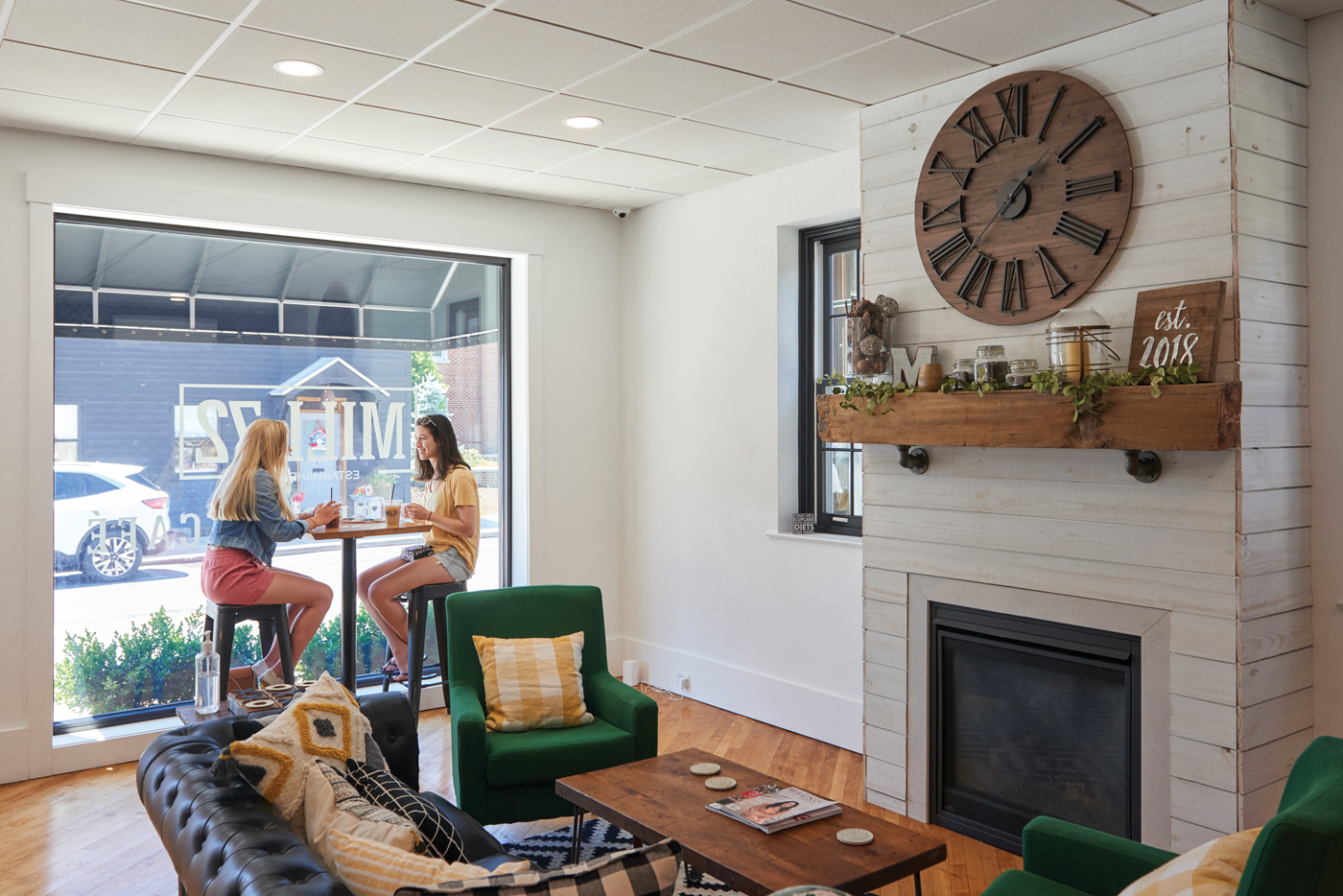
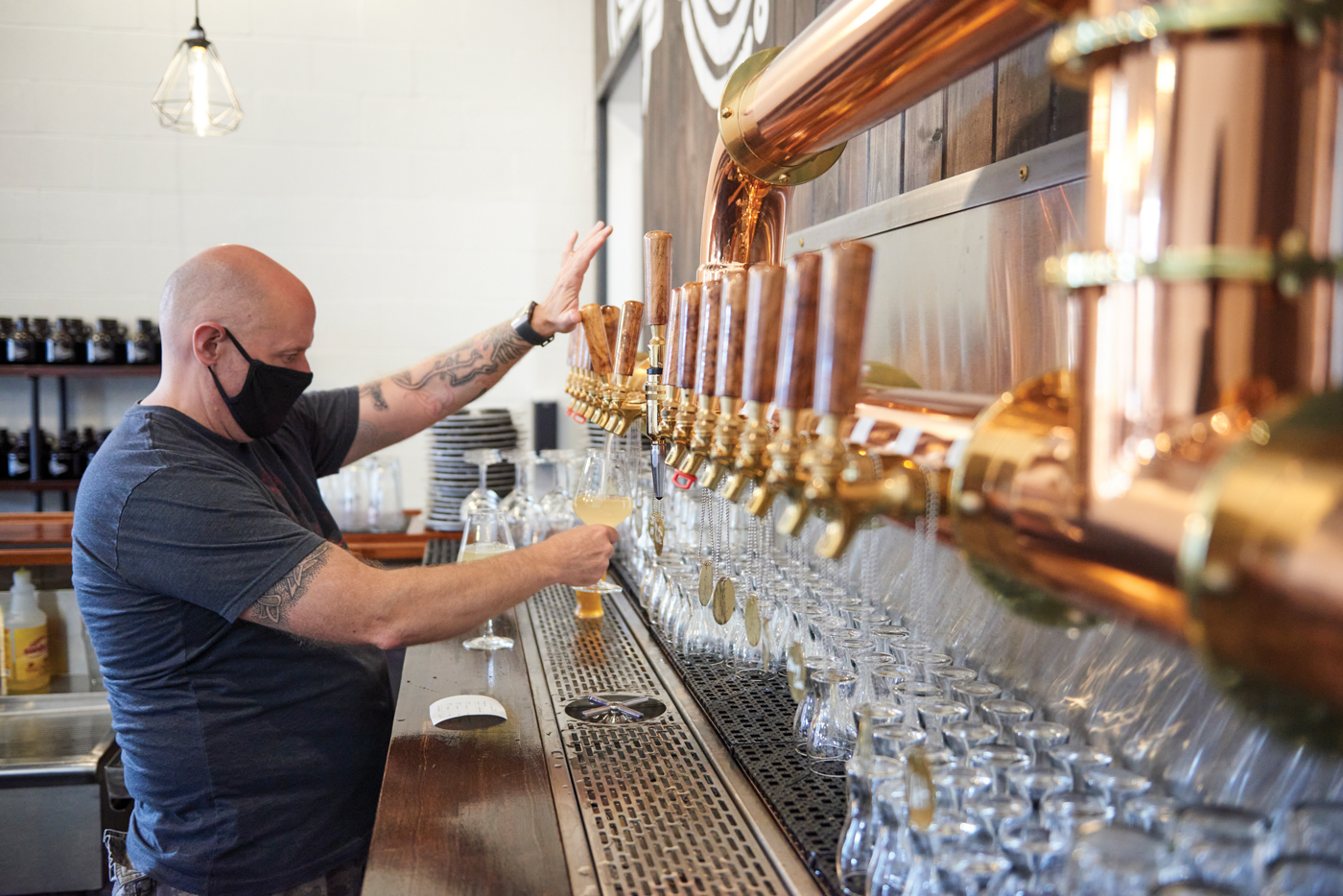
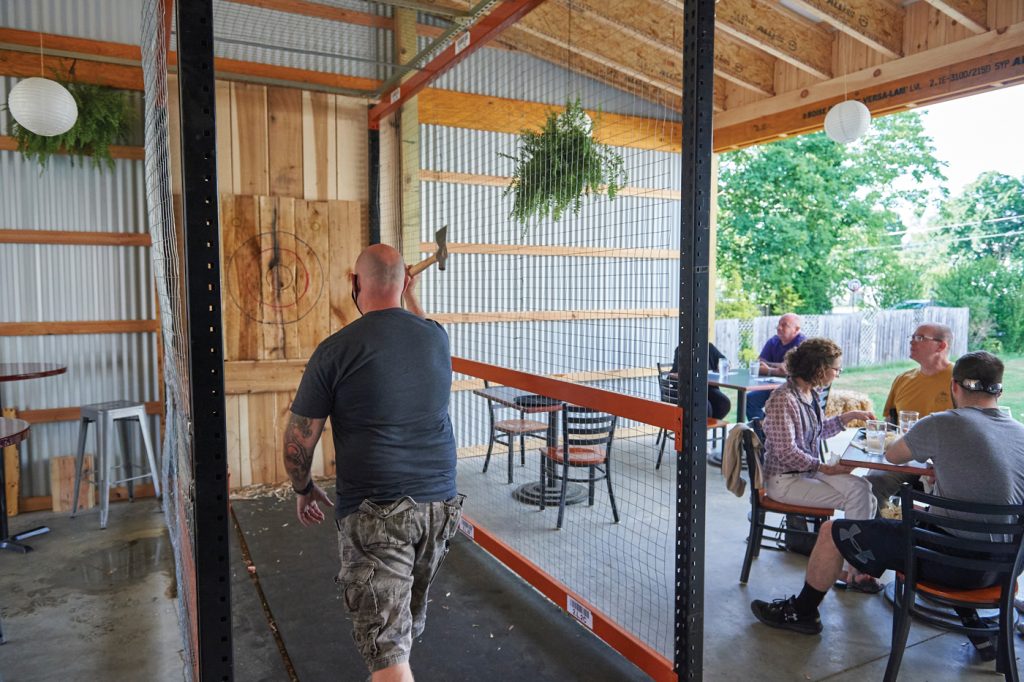
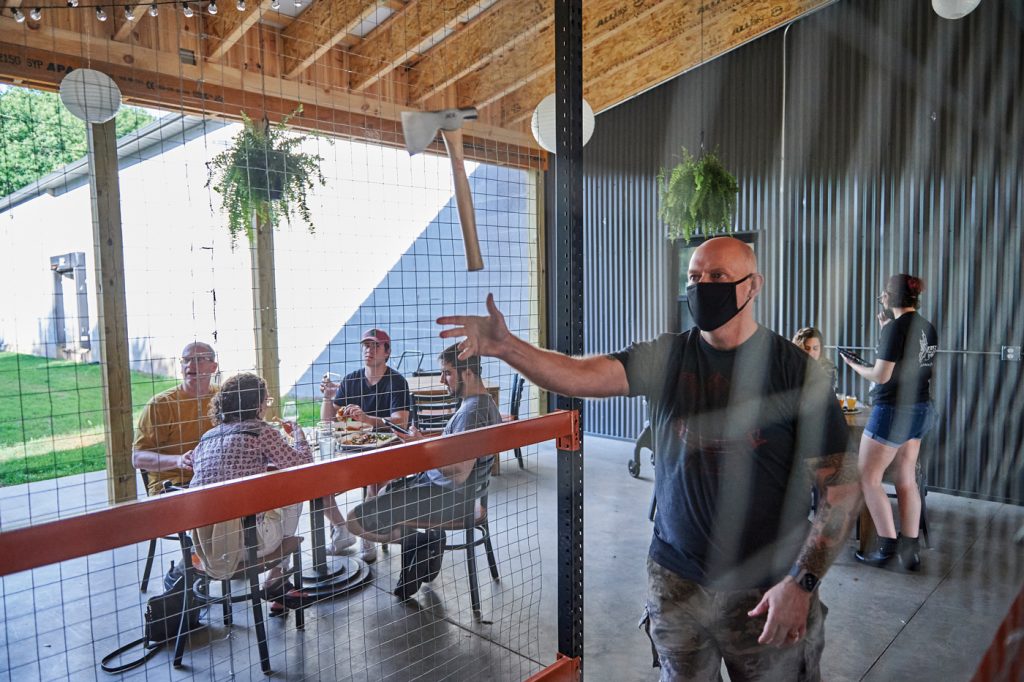
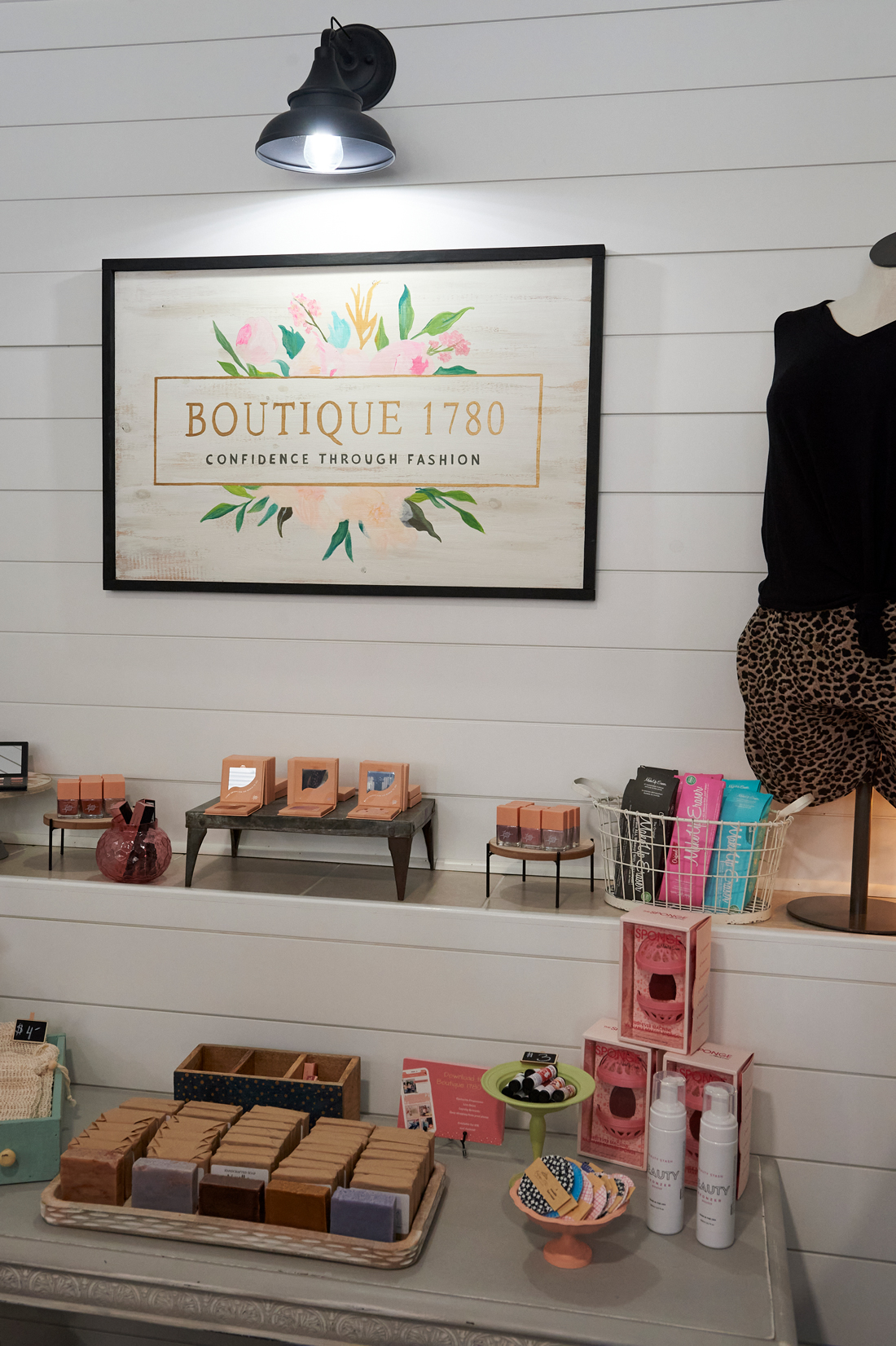
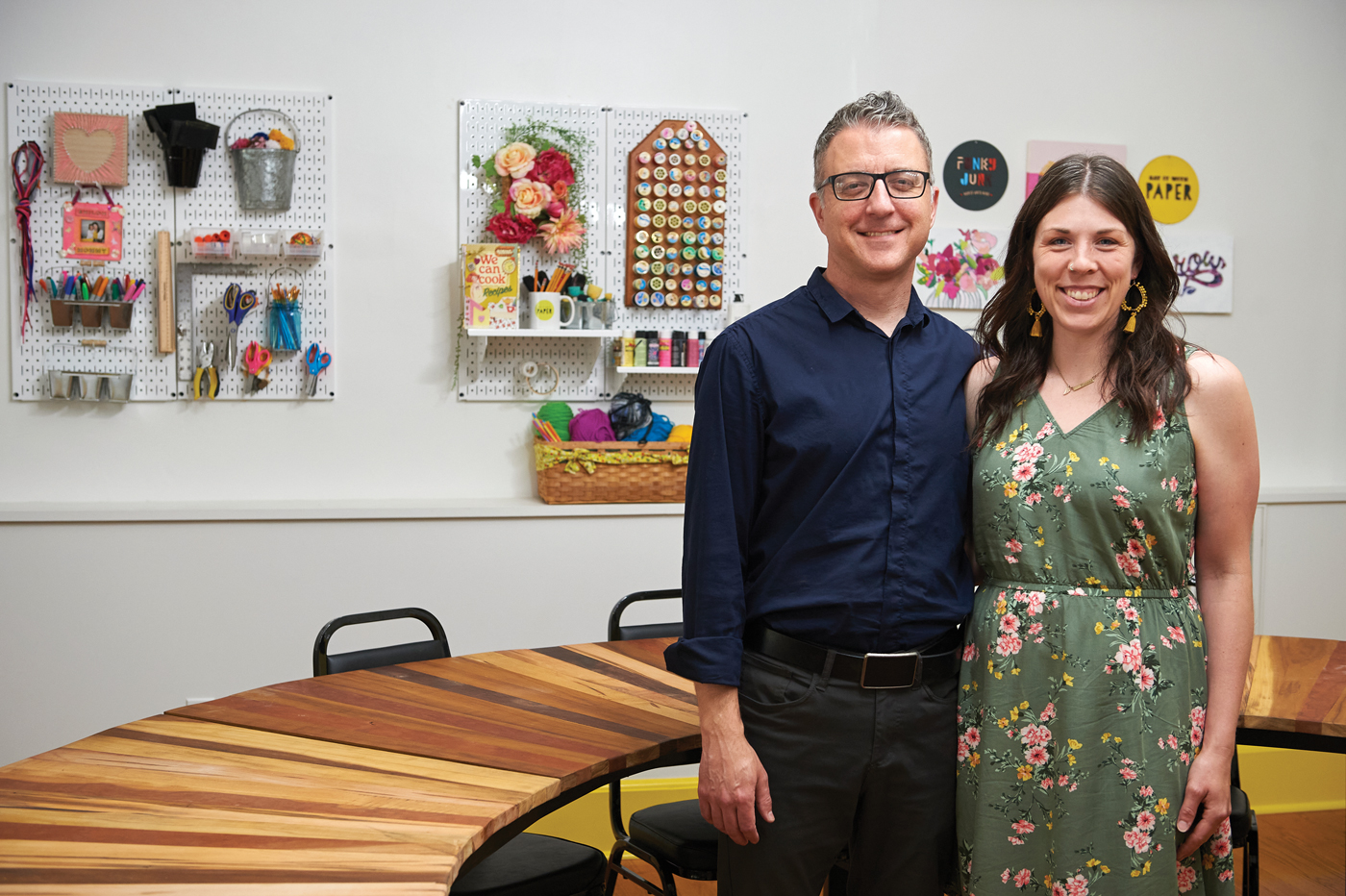
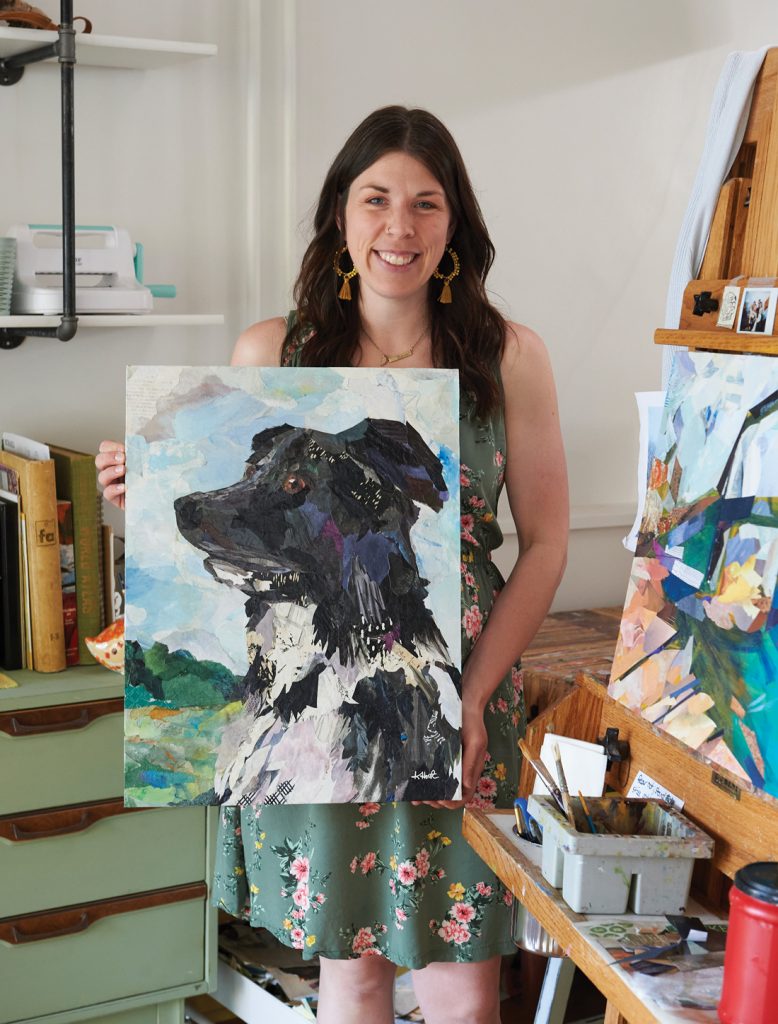
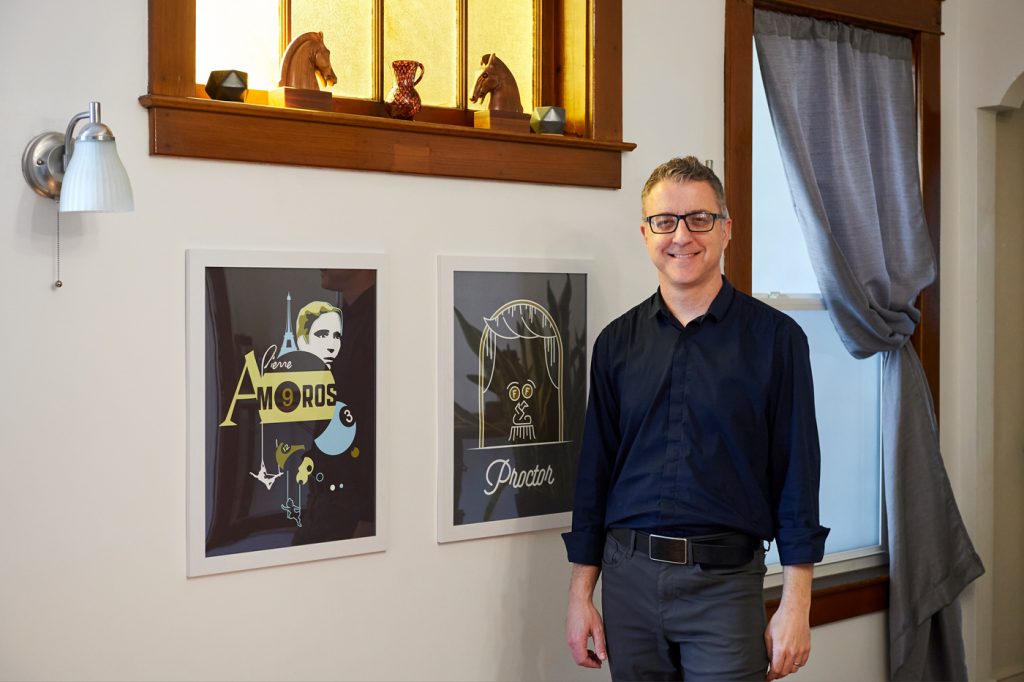
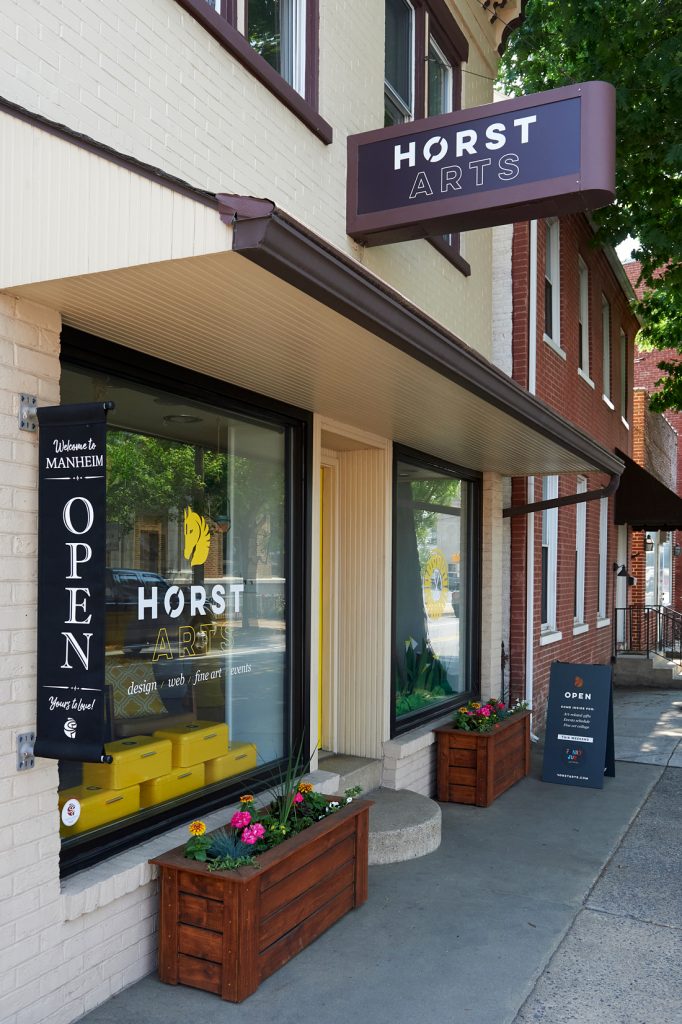
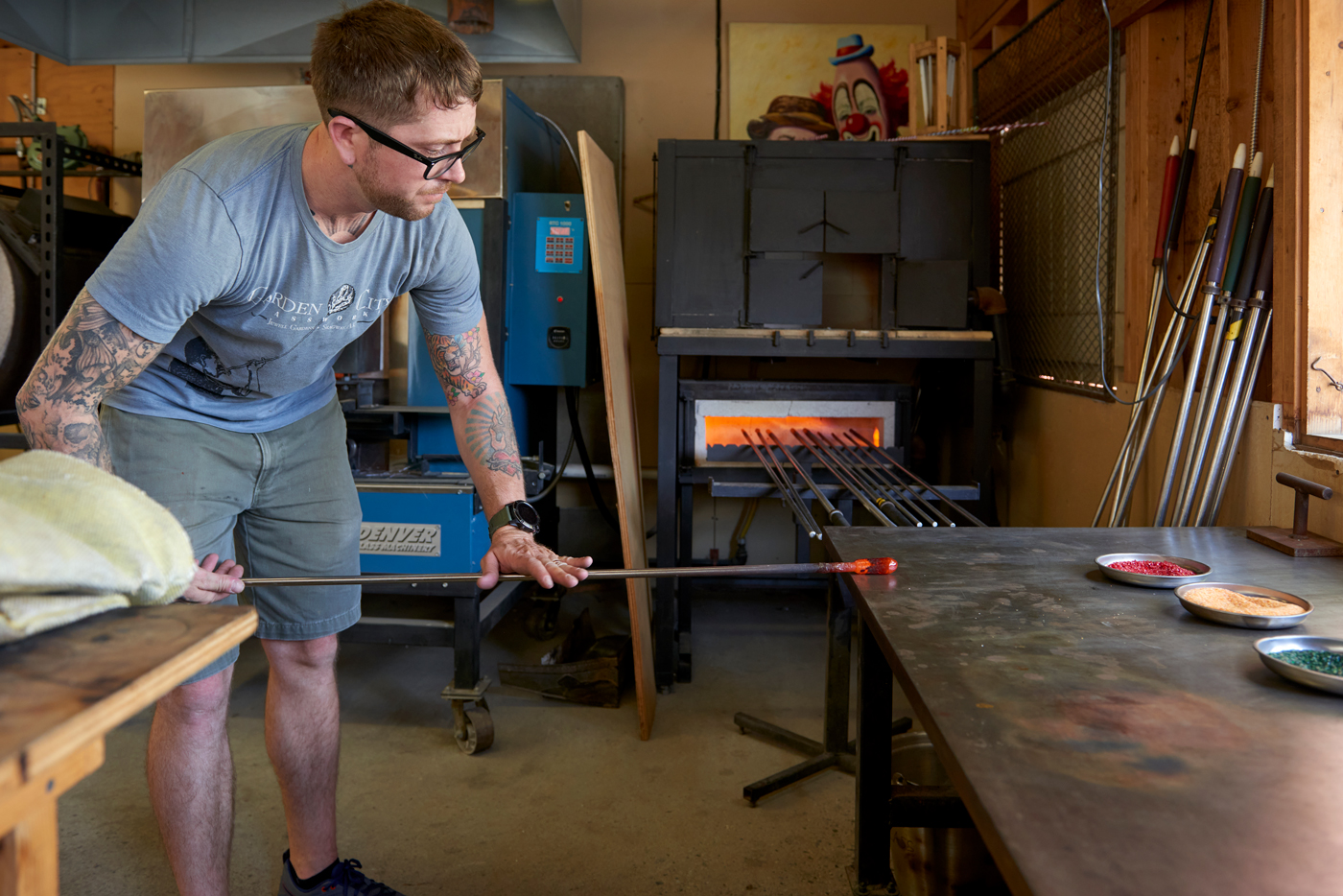
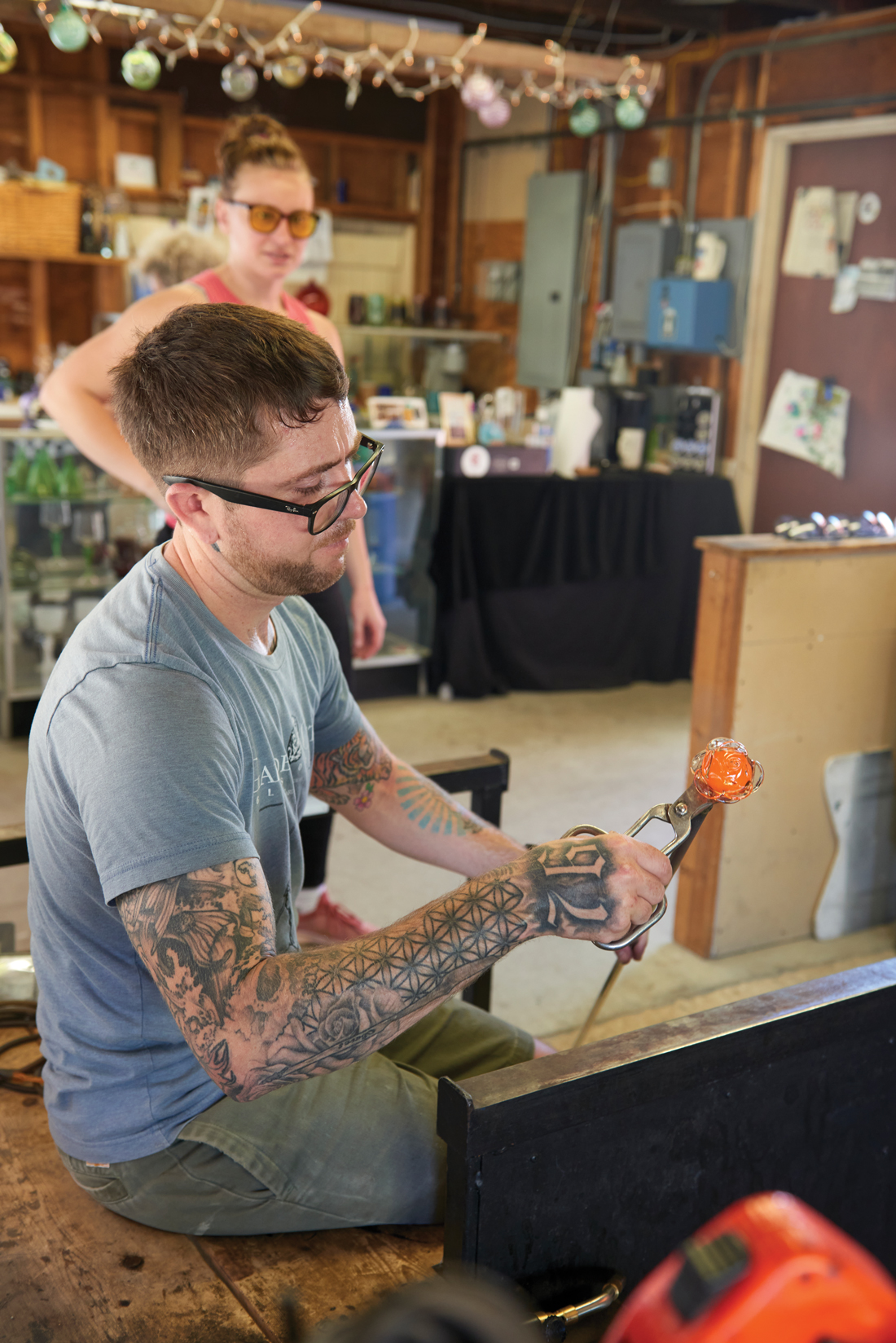
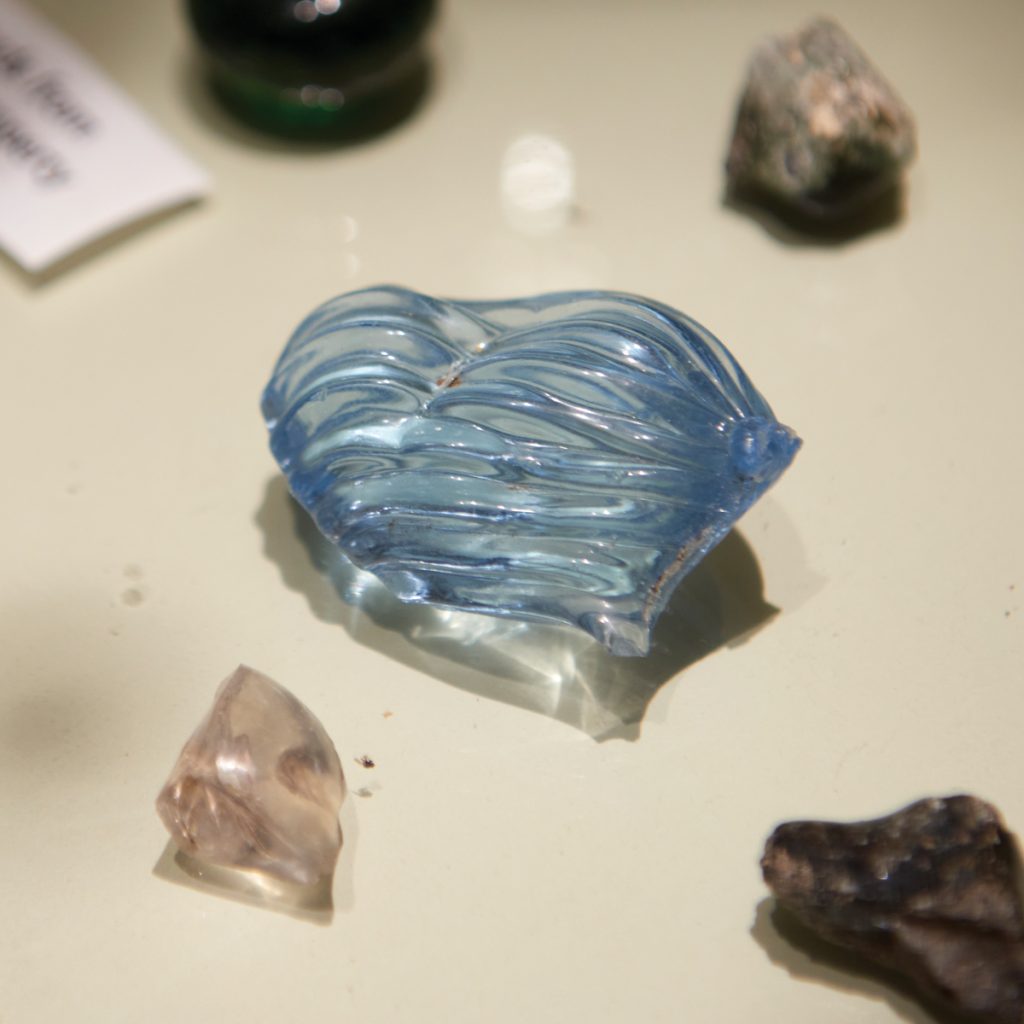
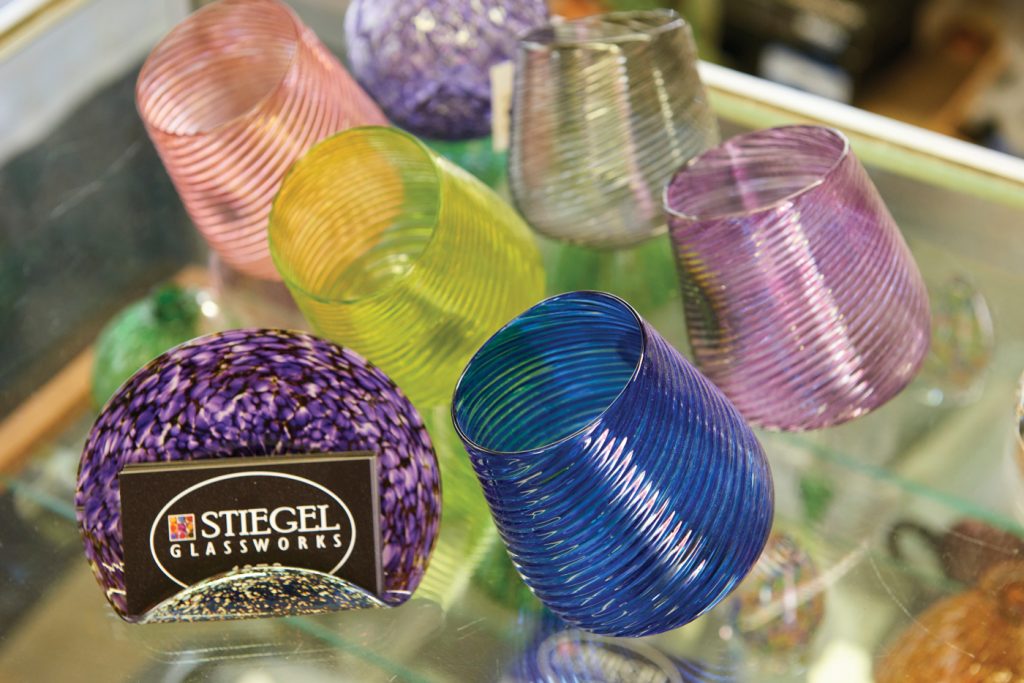
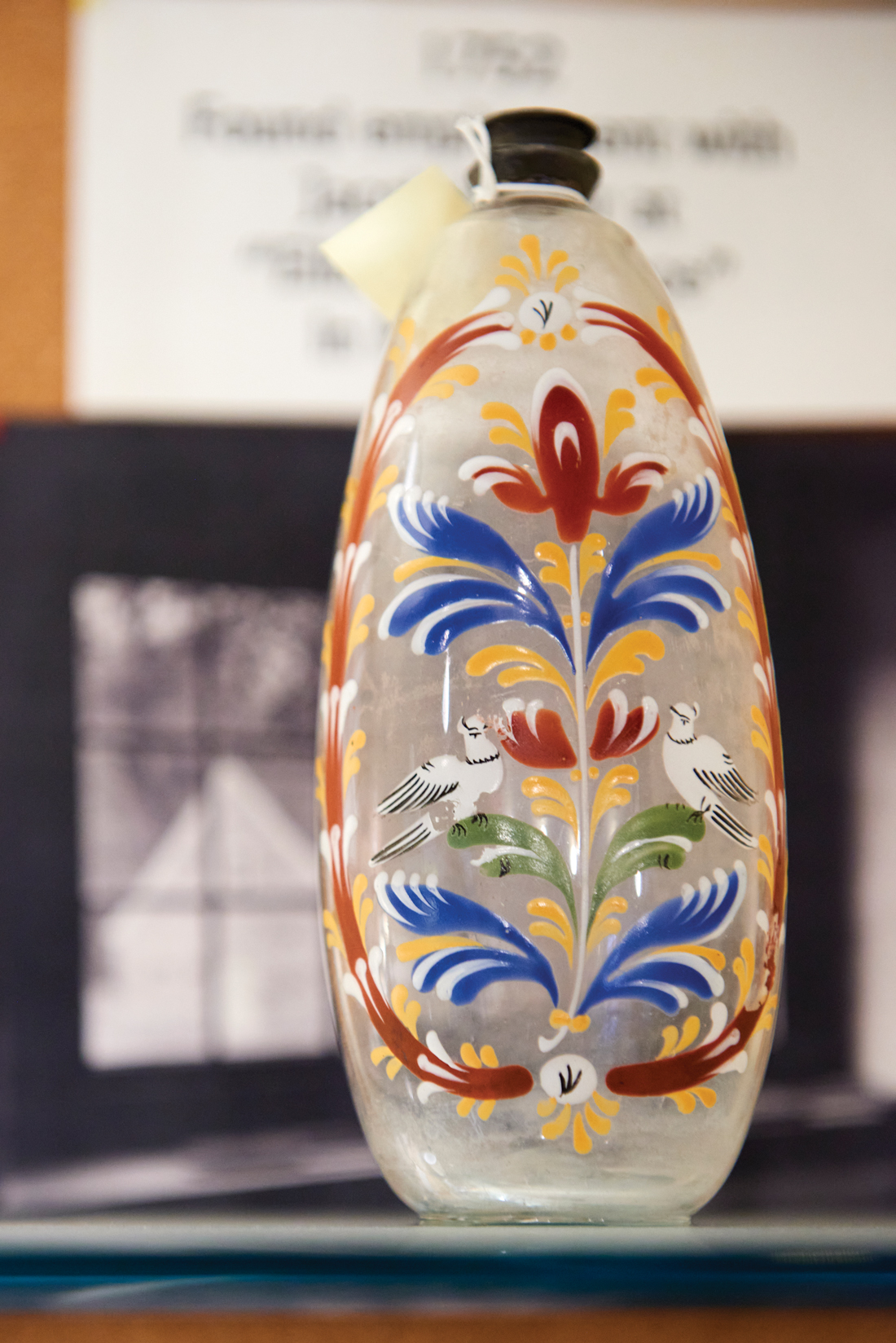
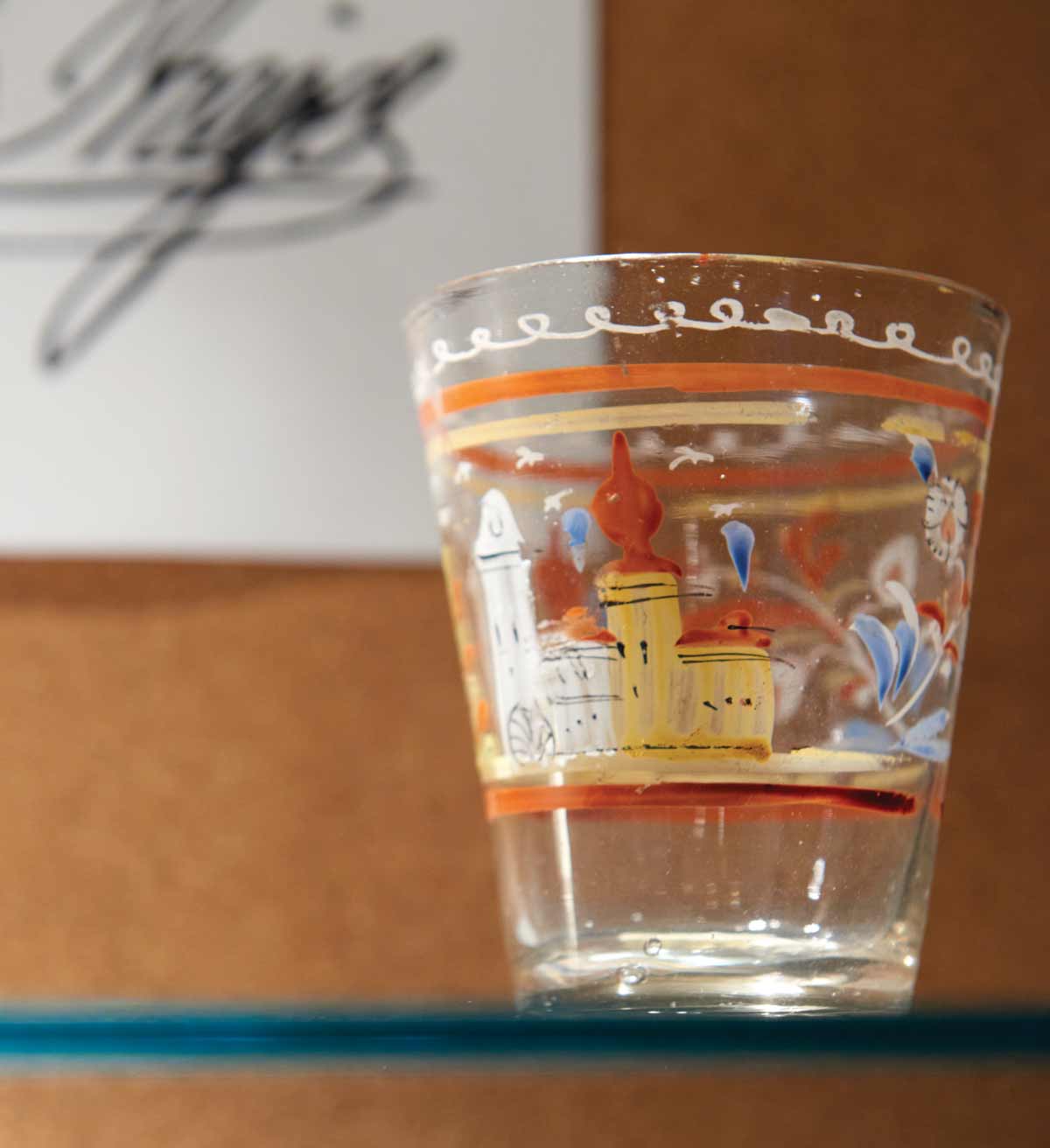
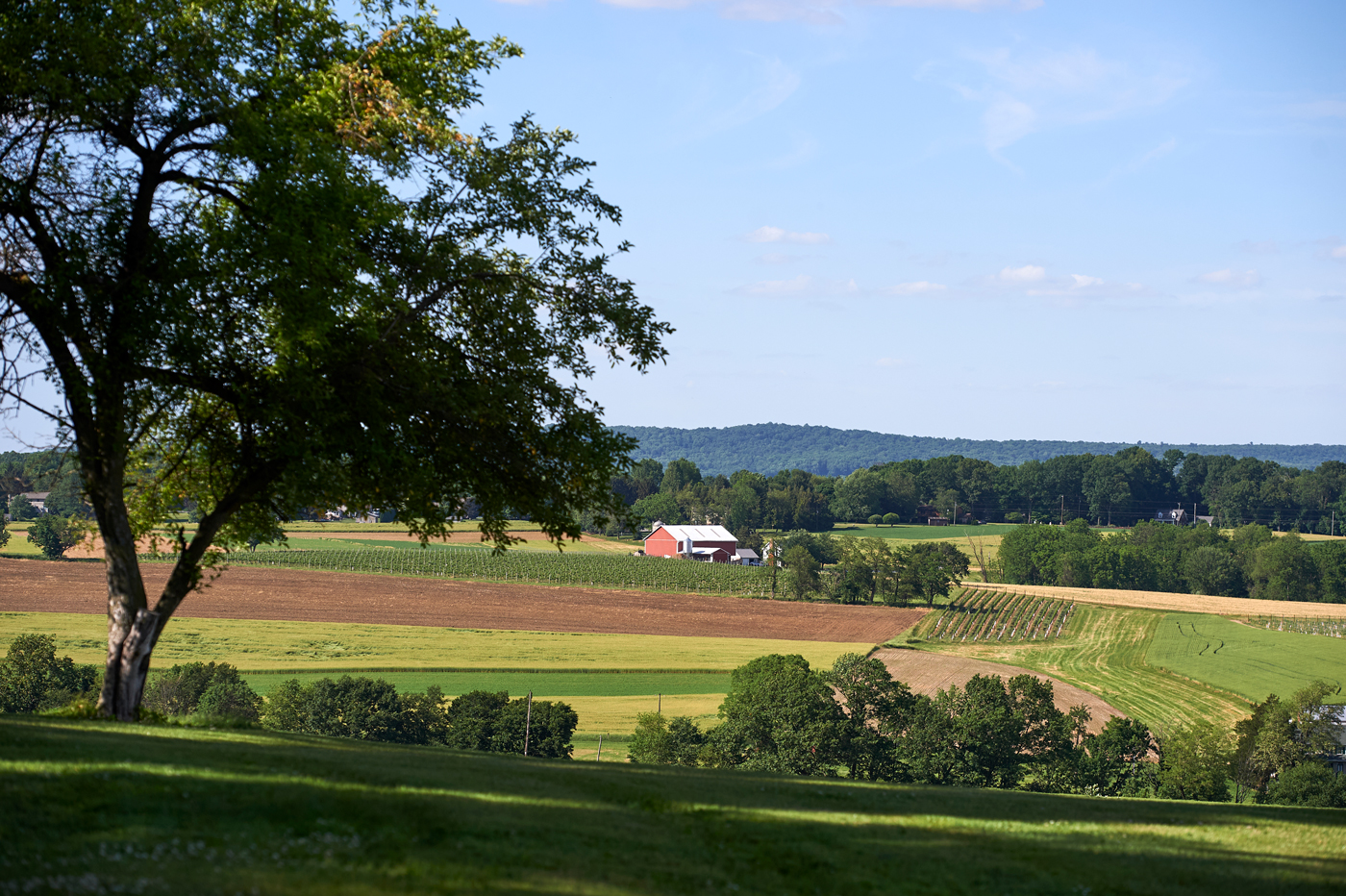
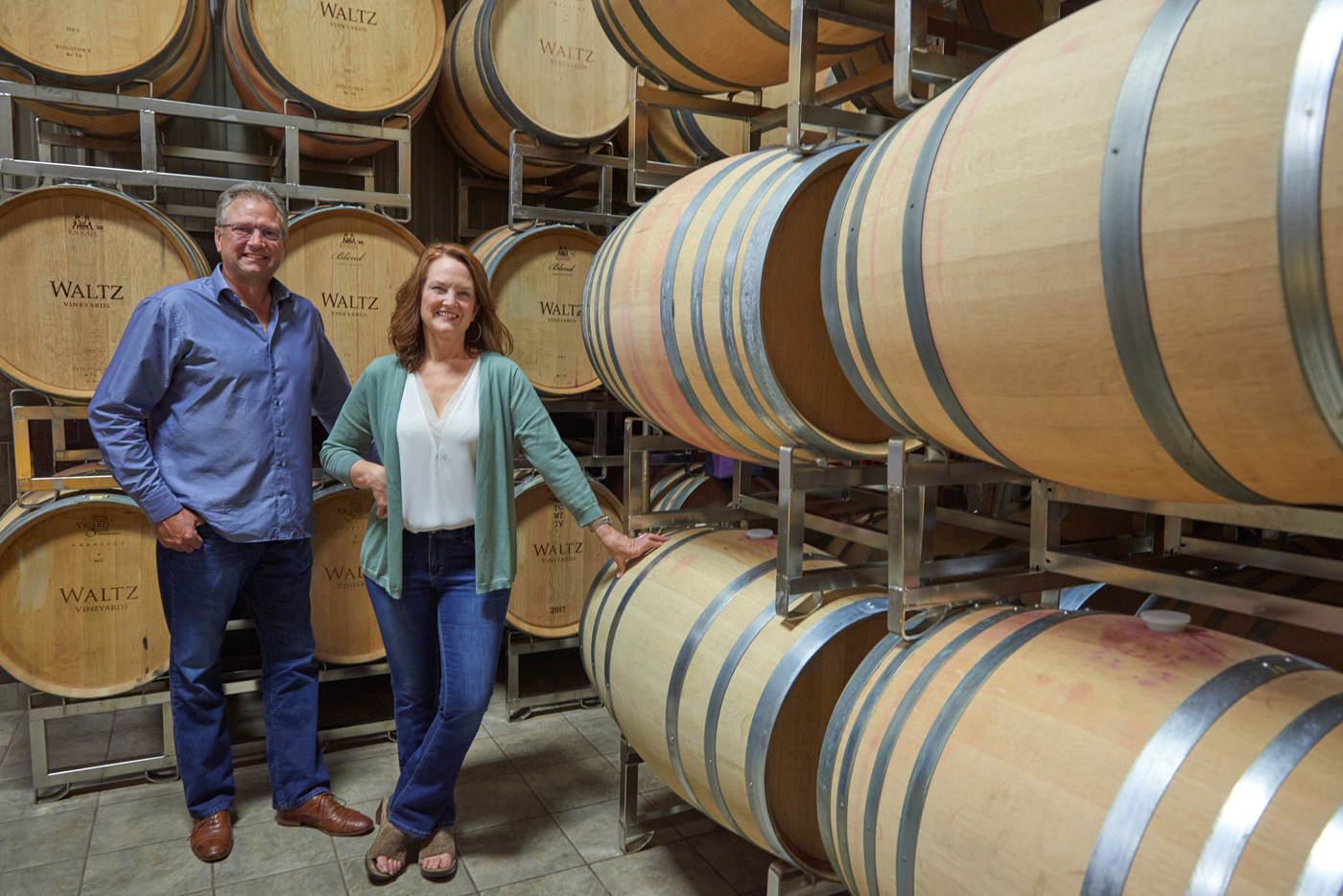
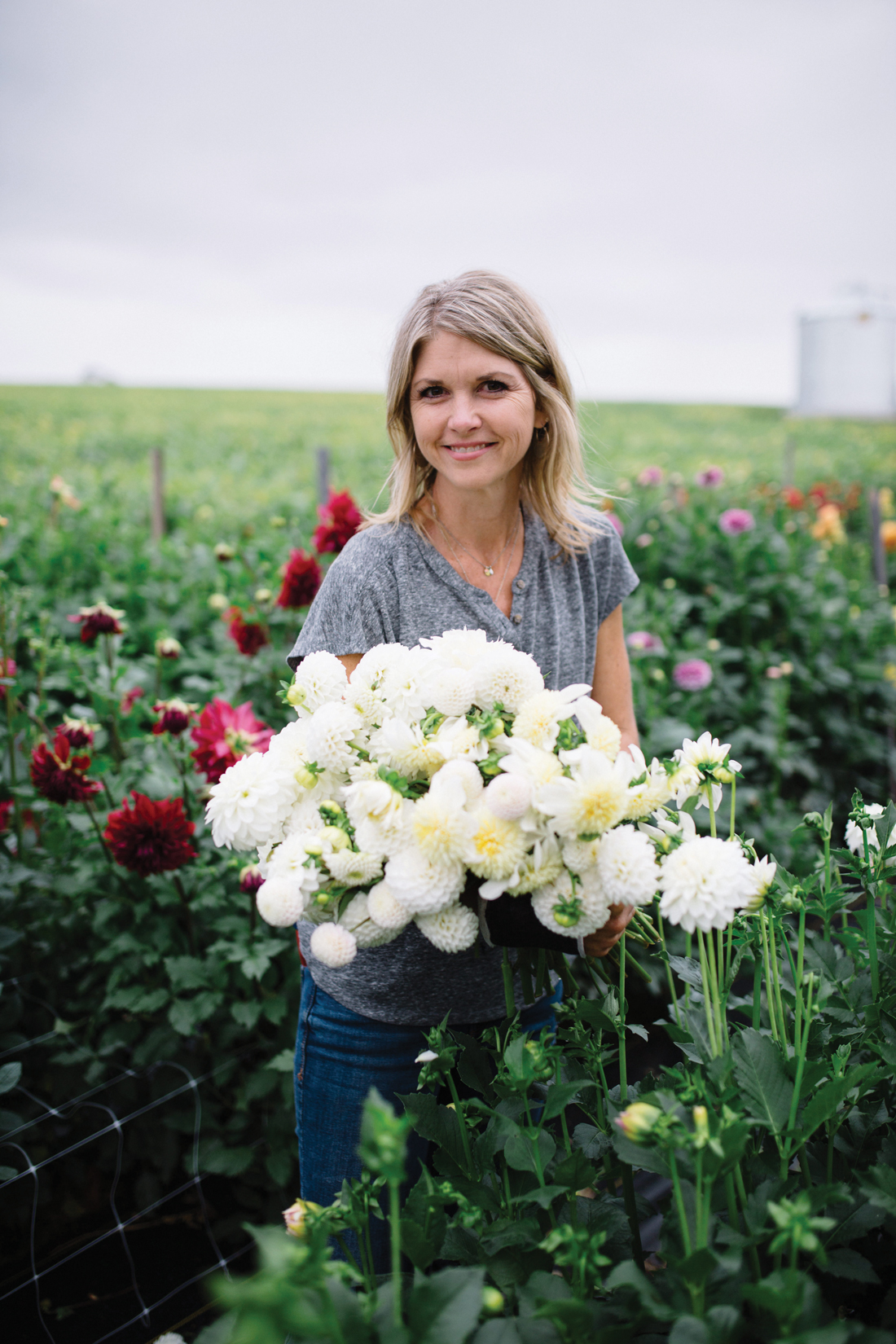

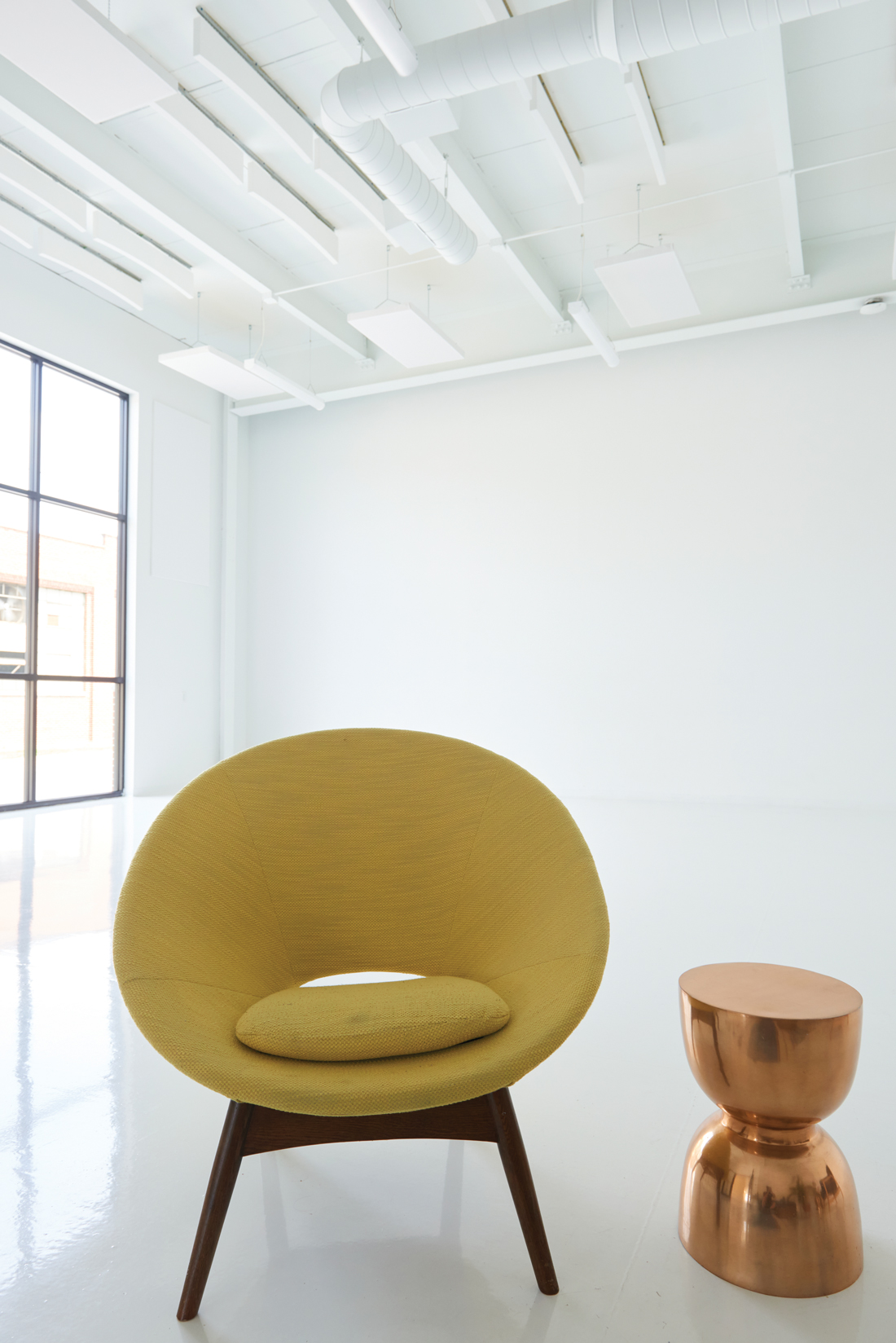
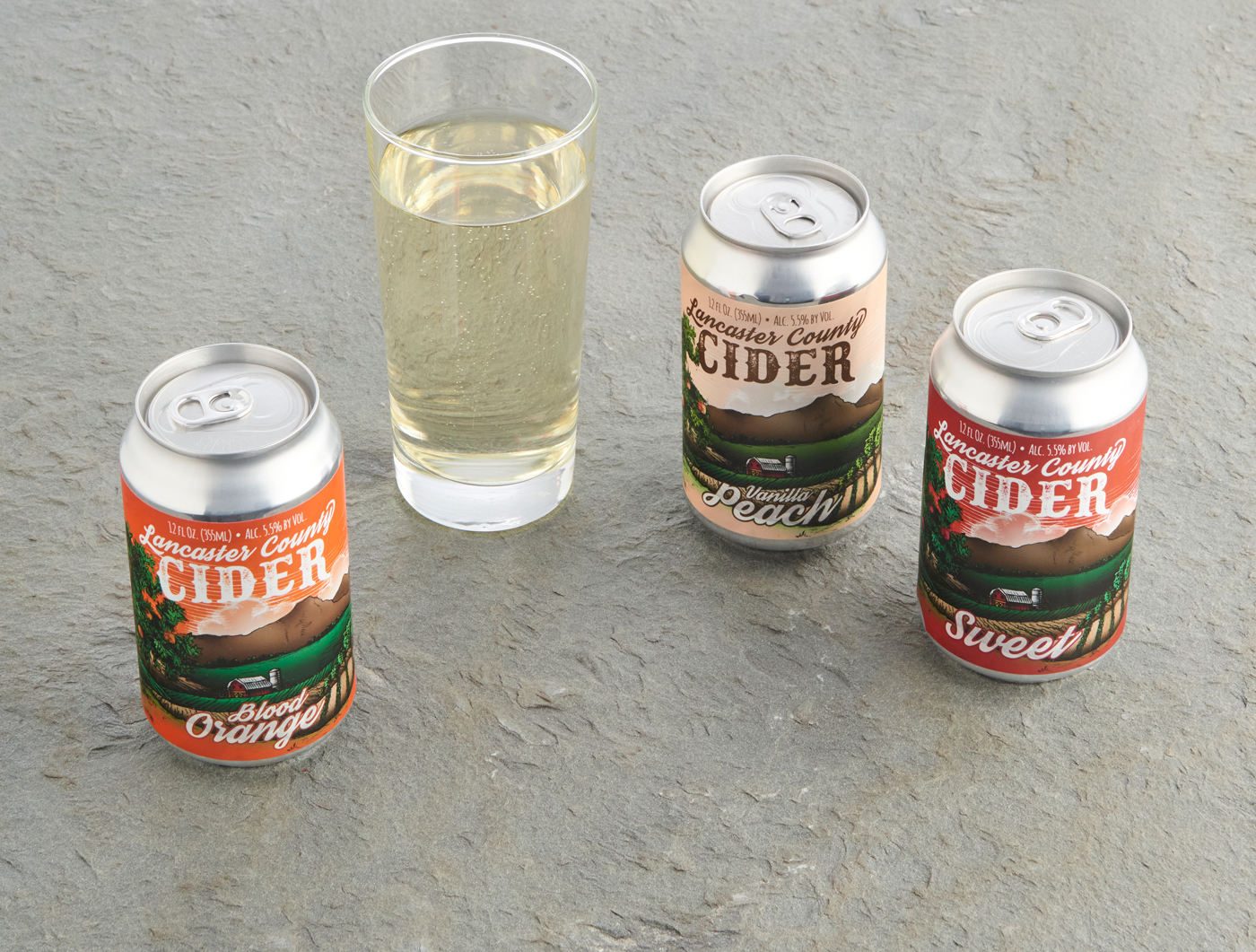
SHARE
PRINT